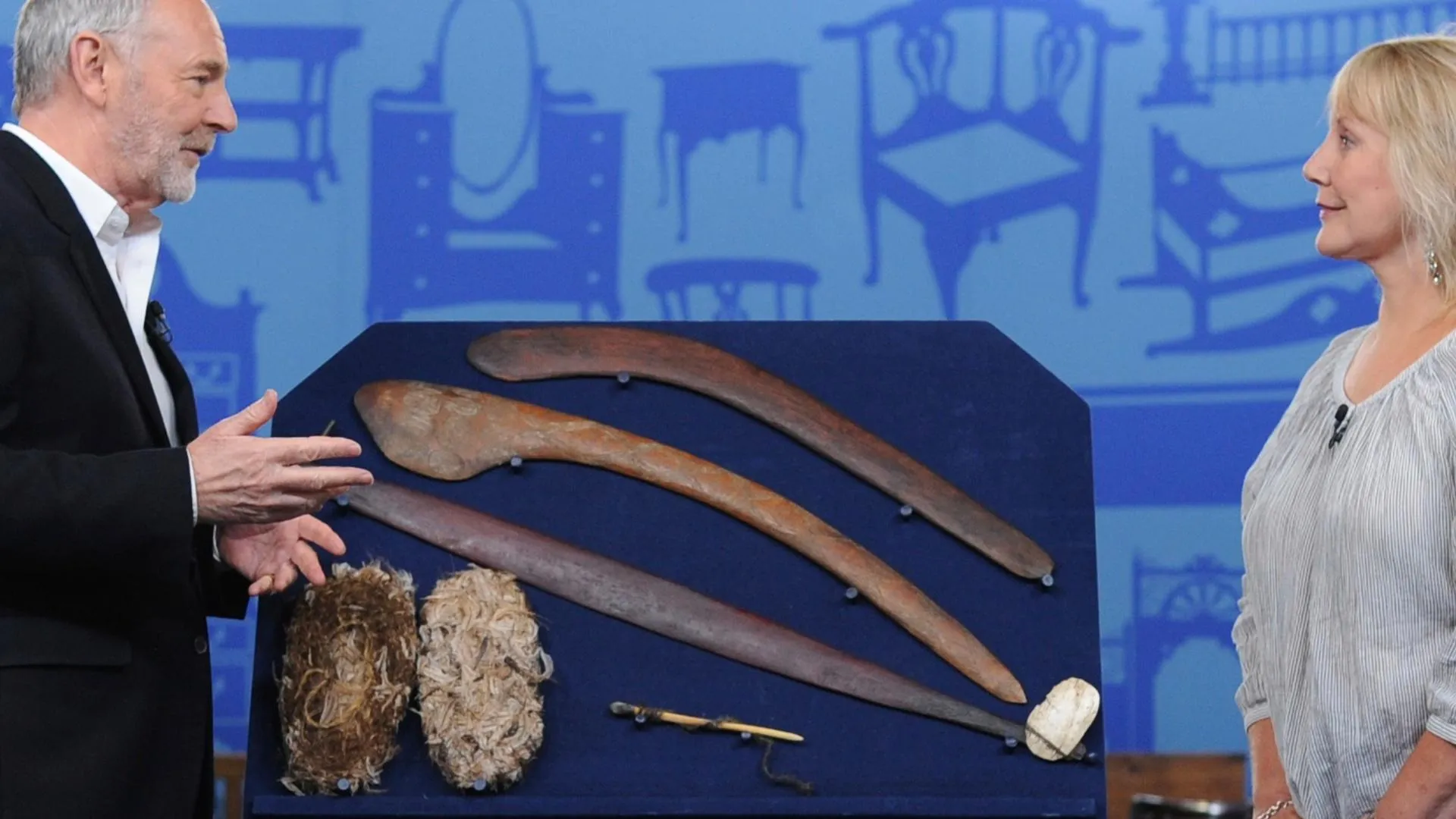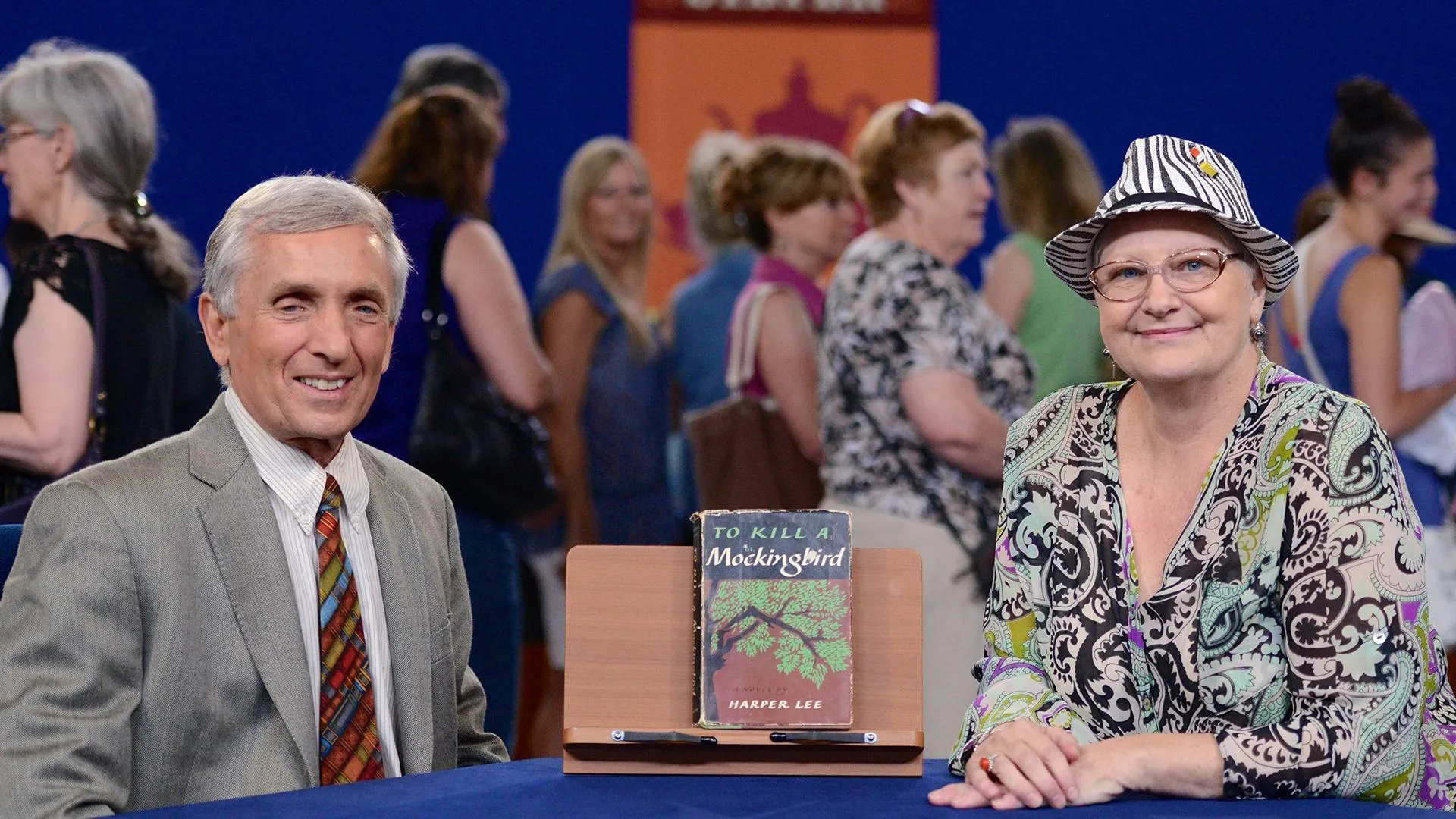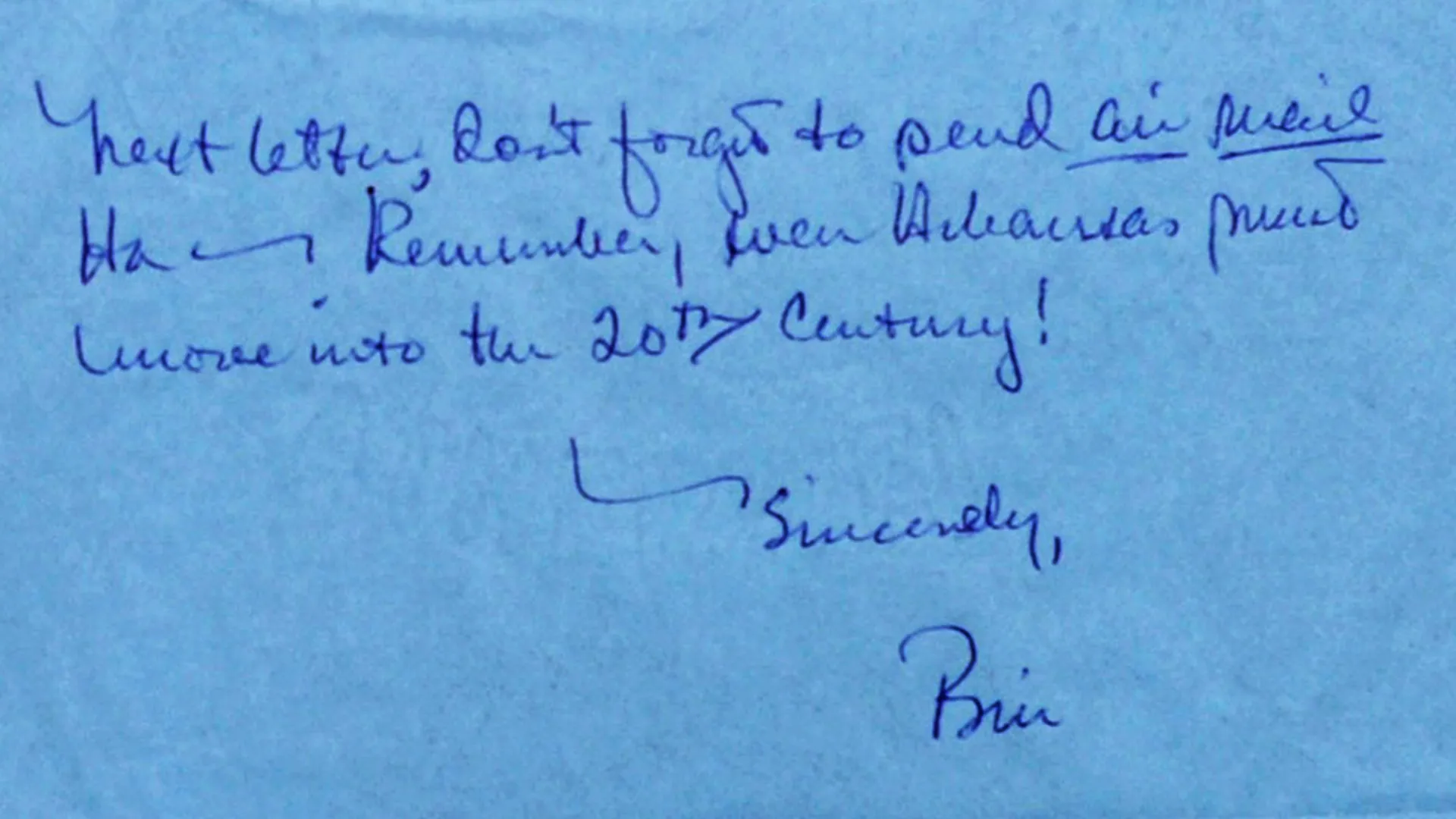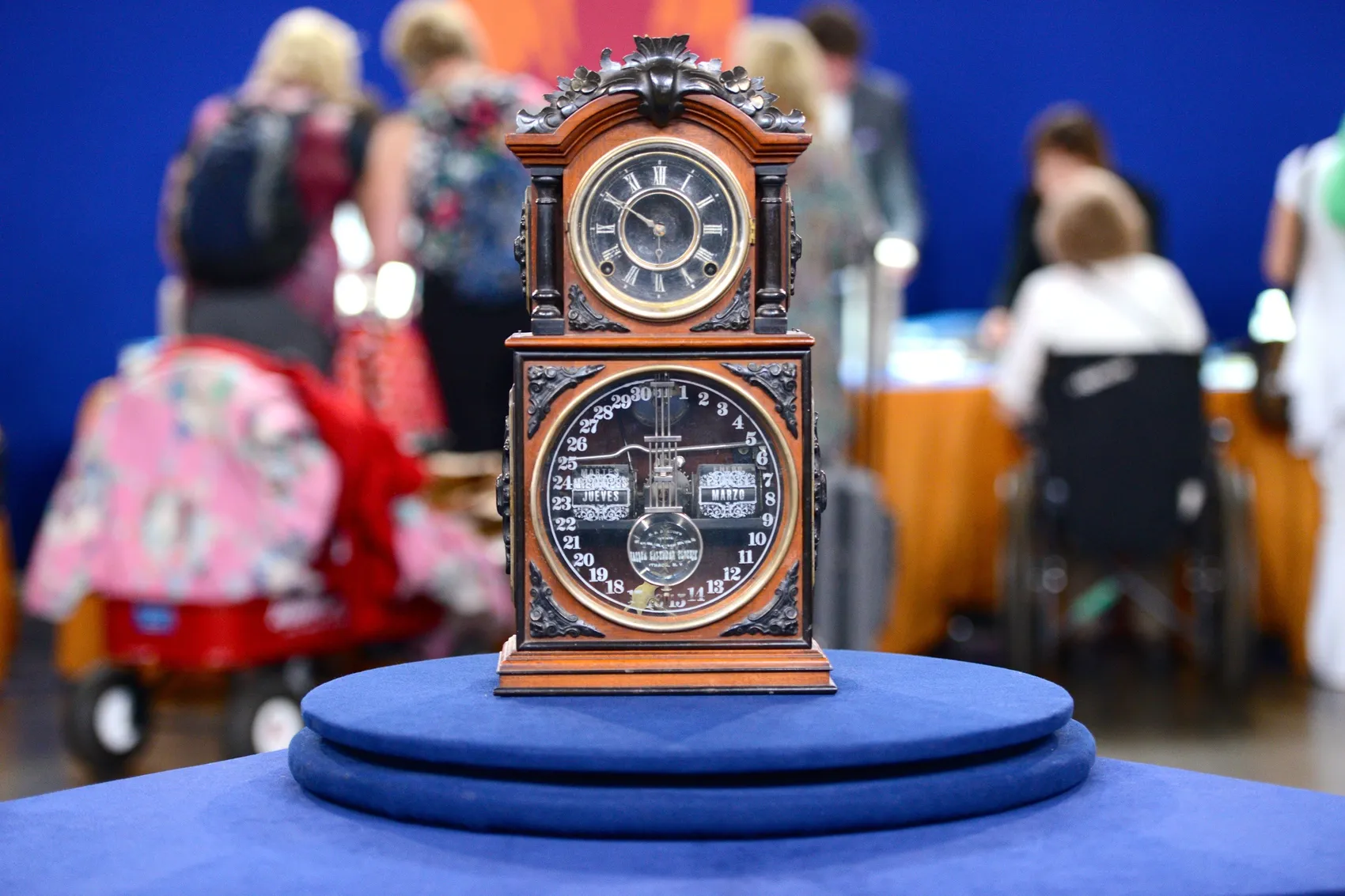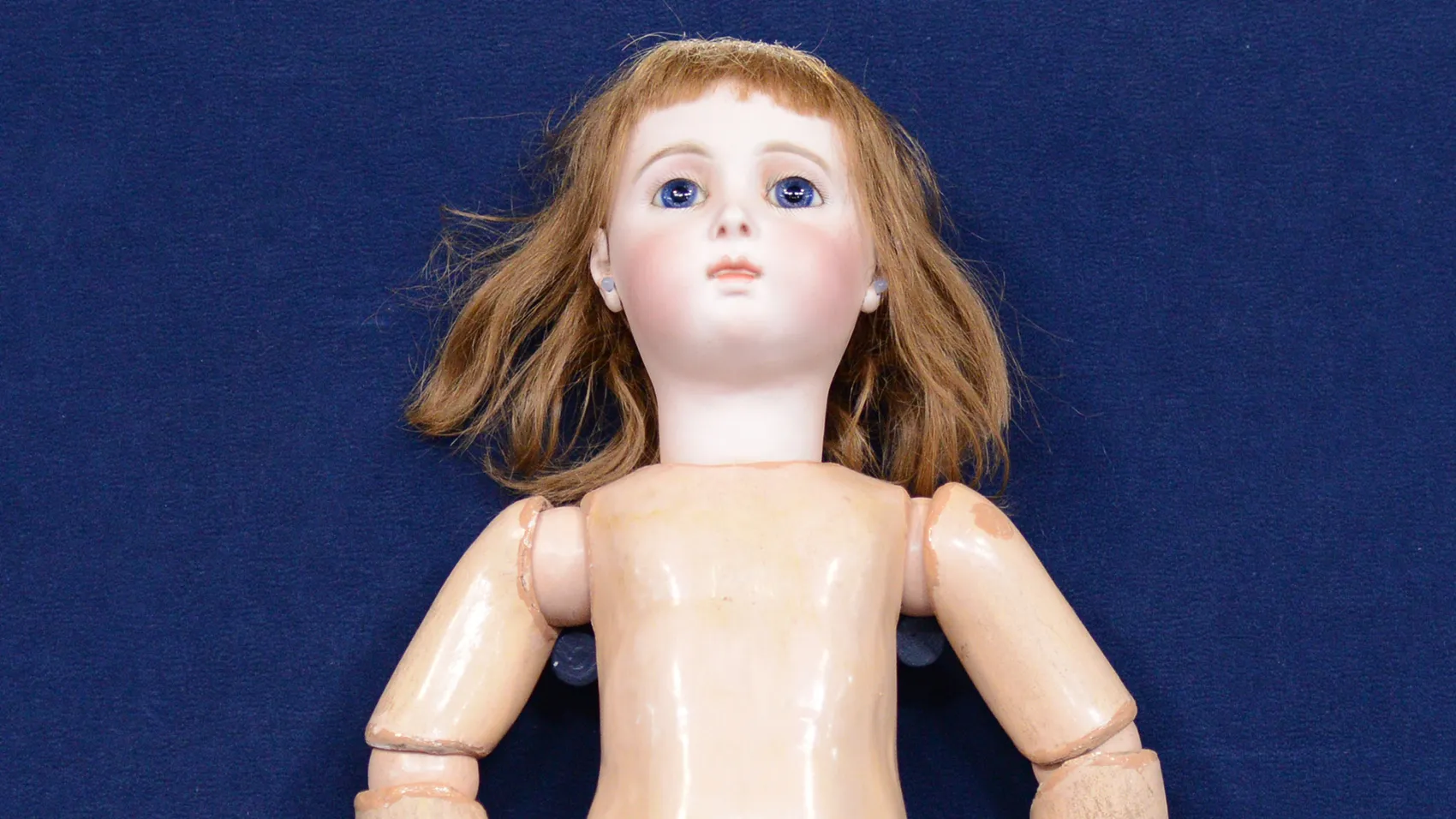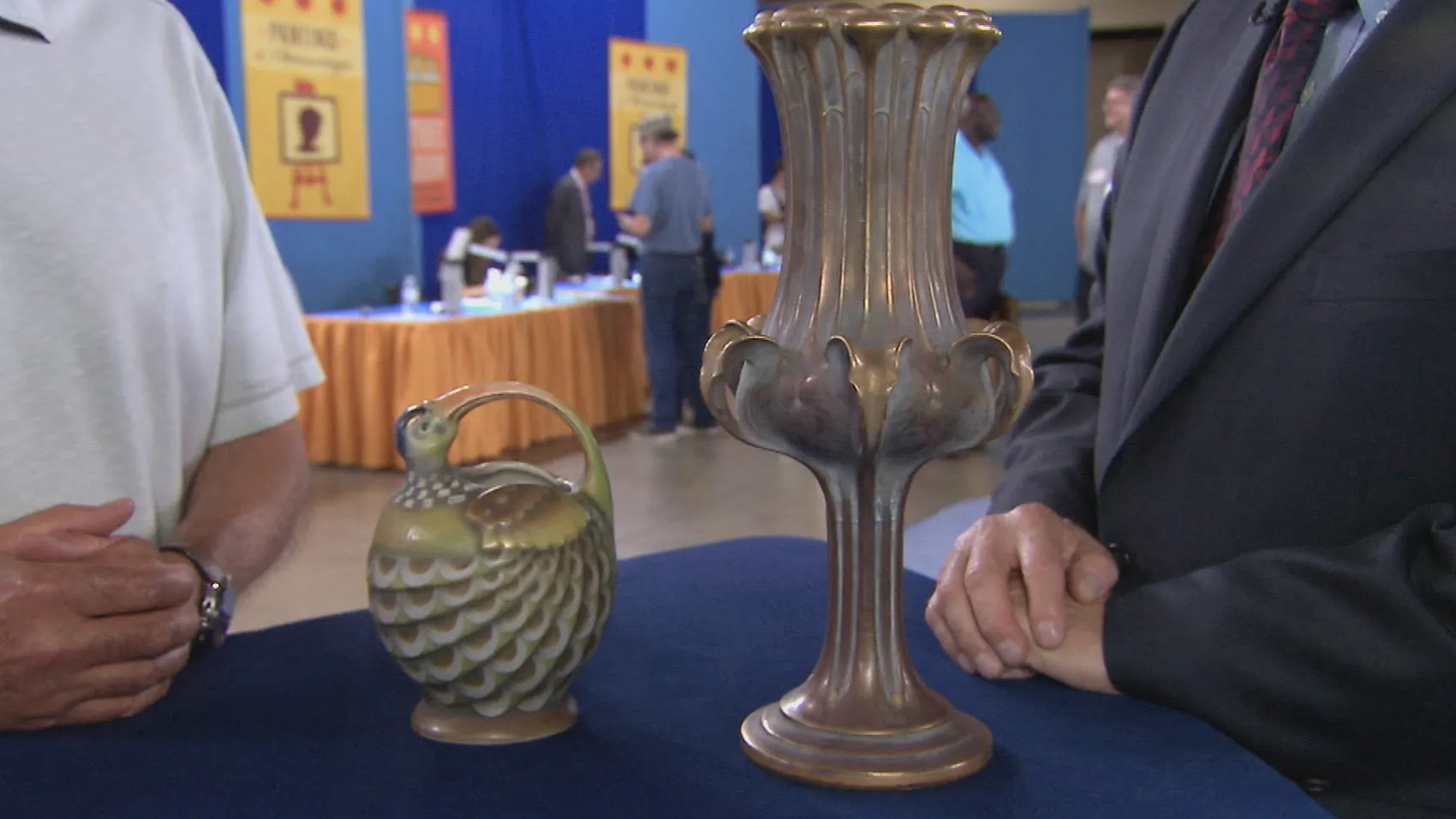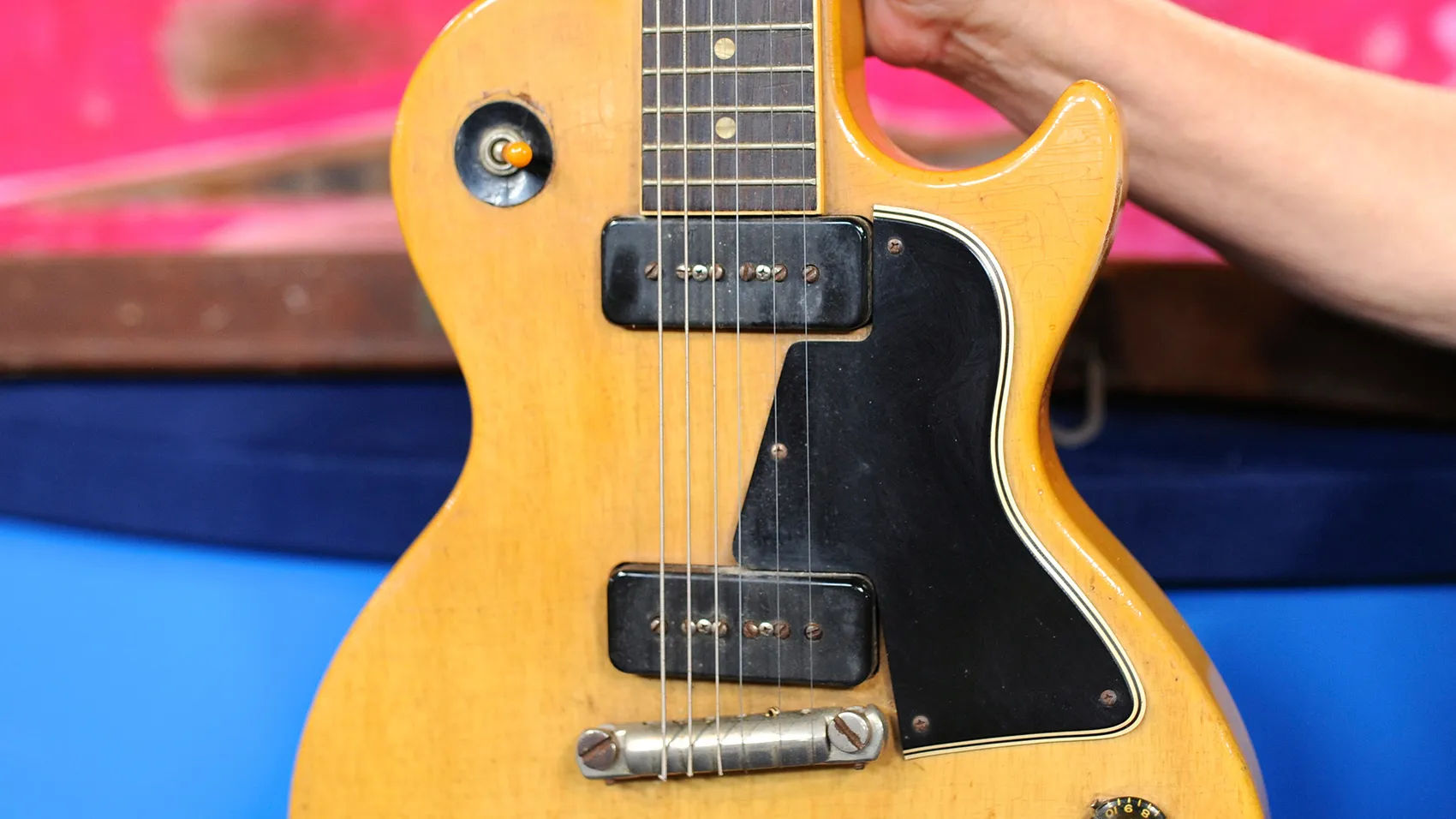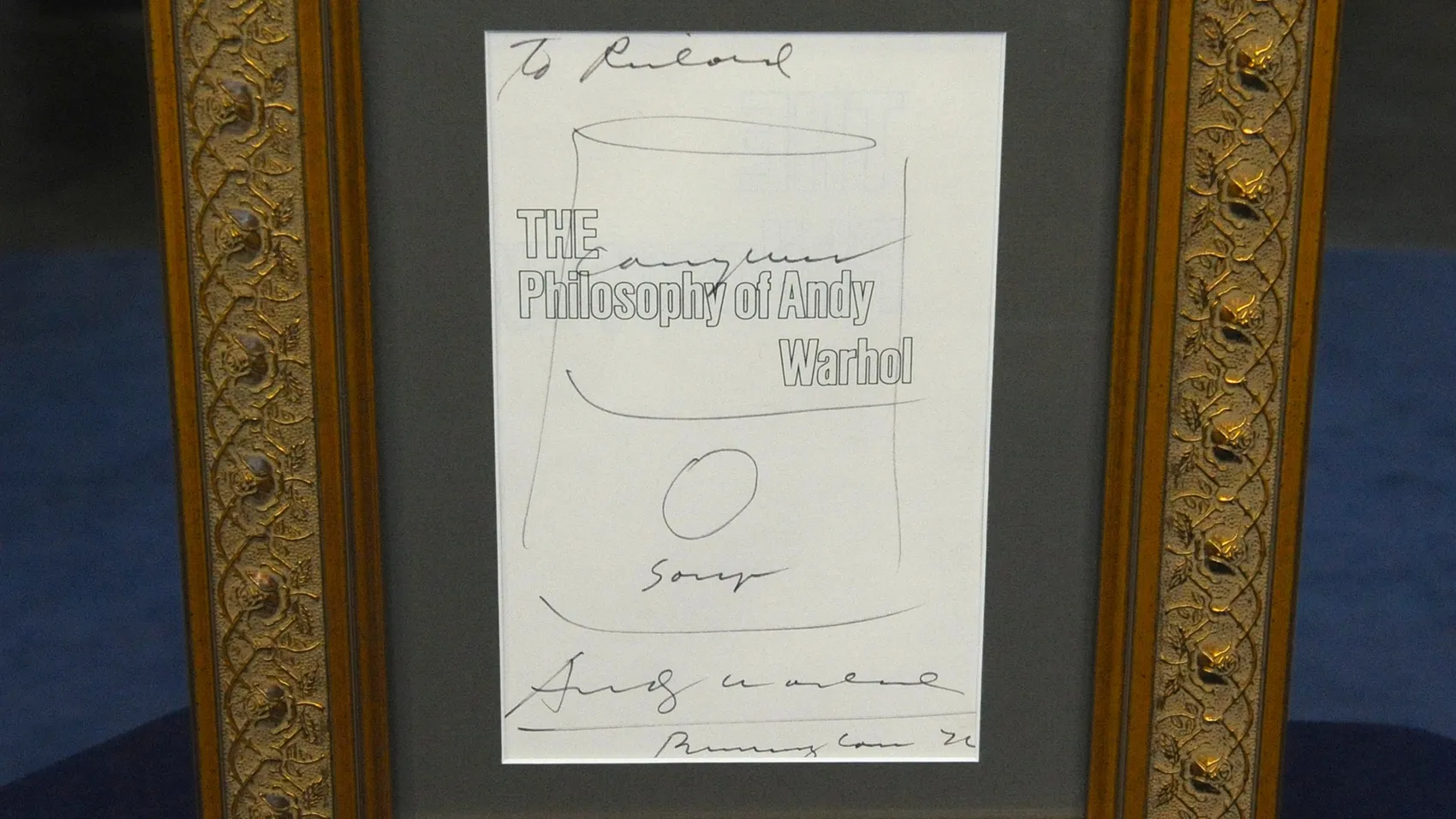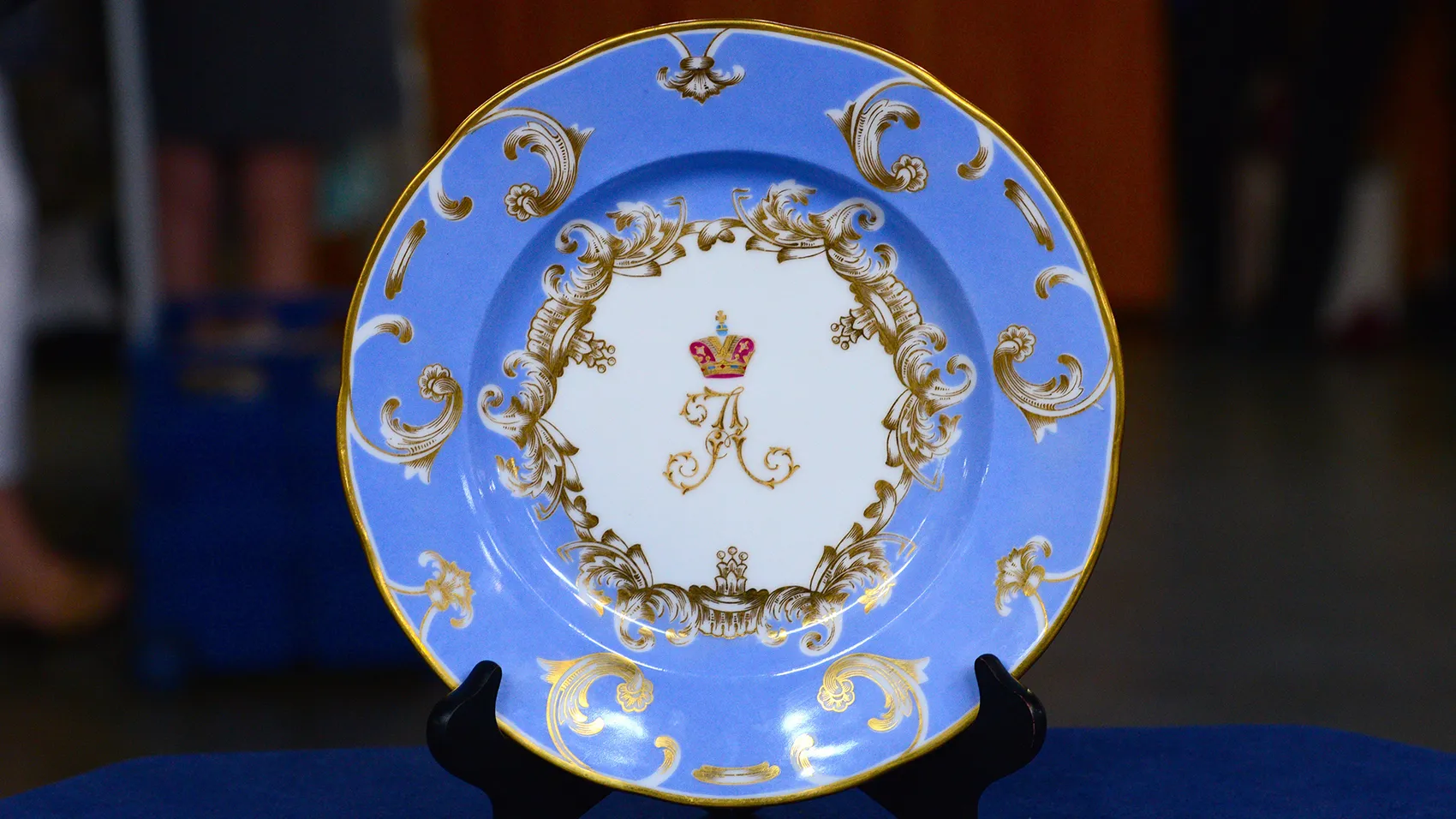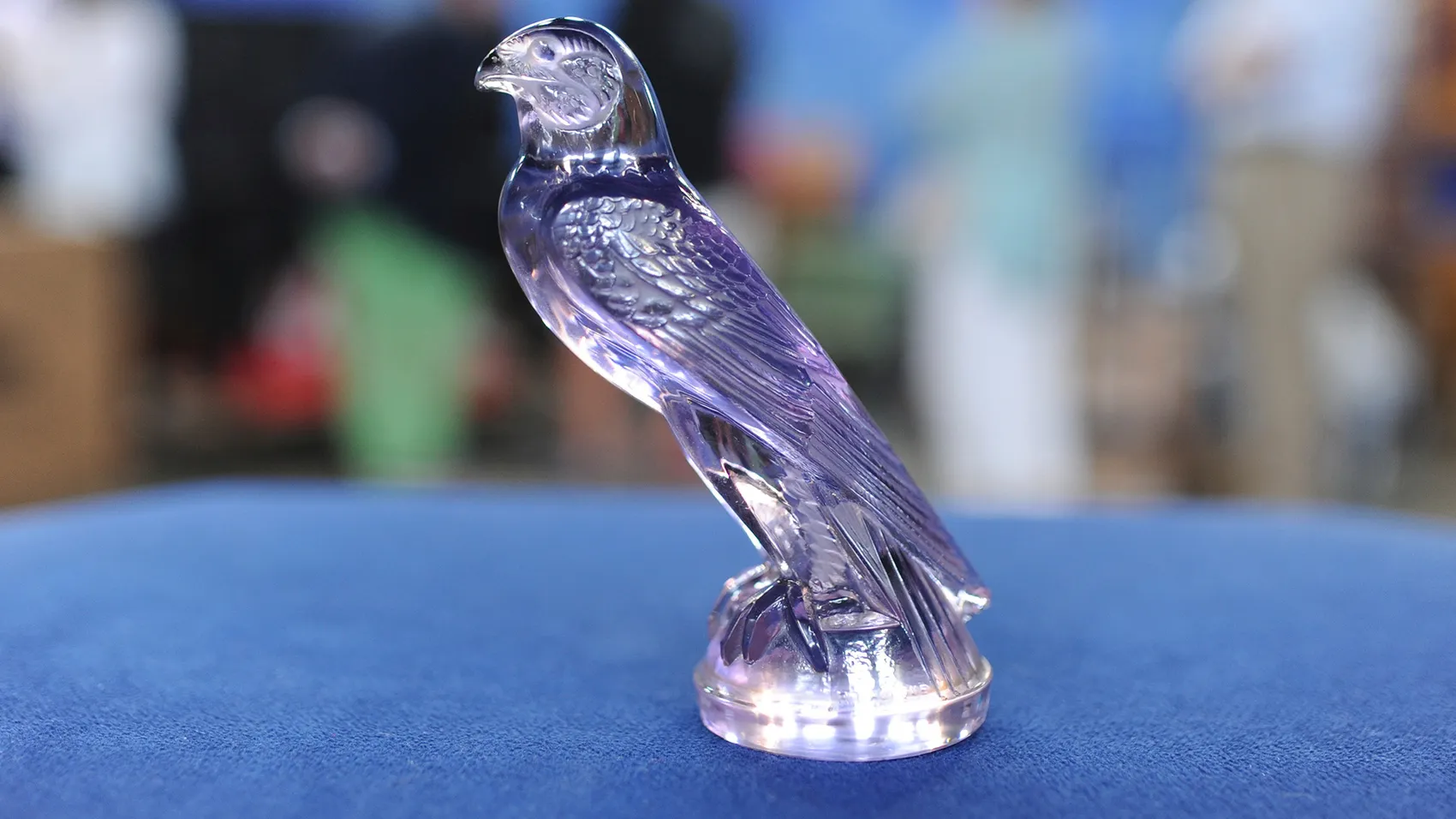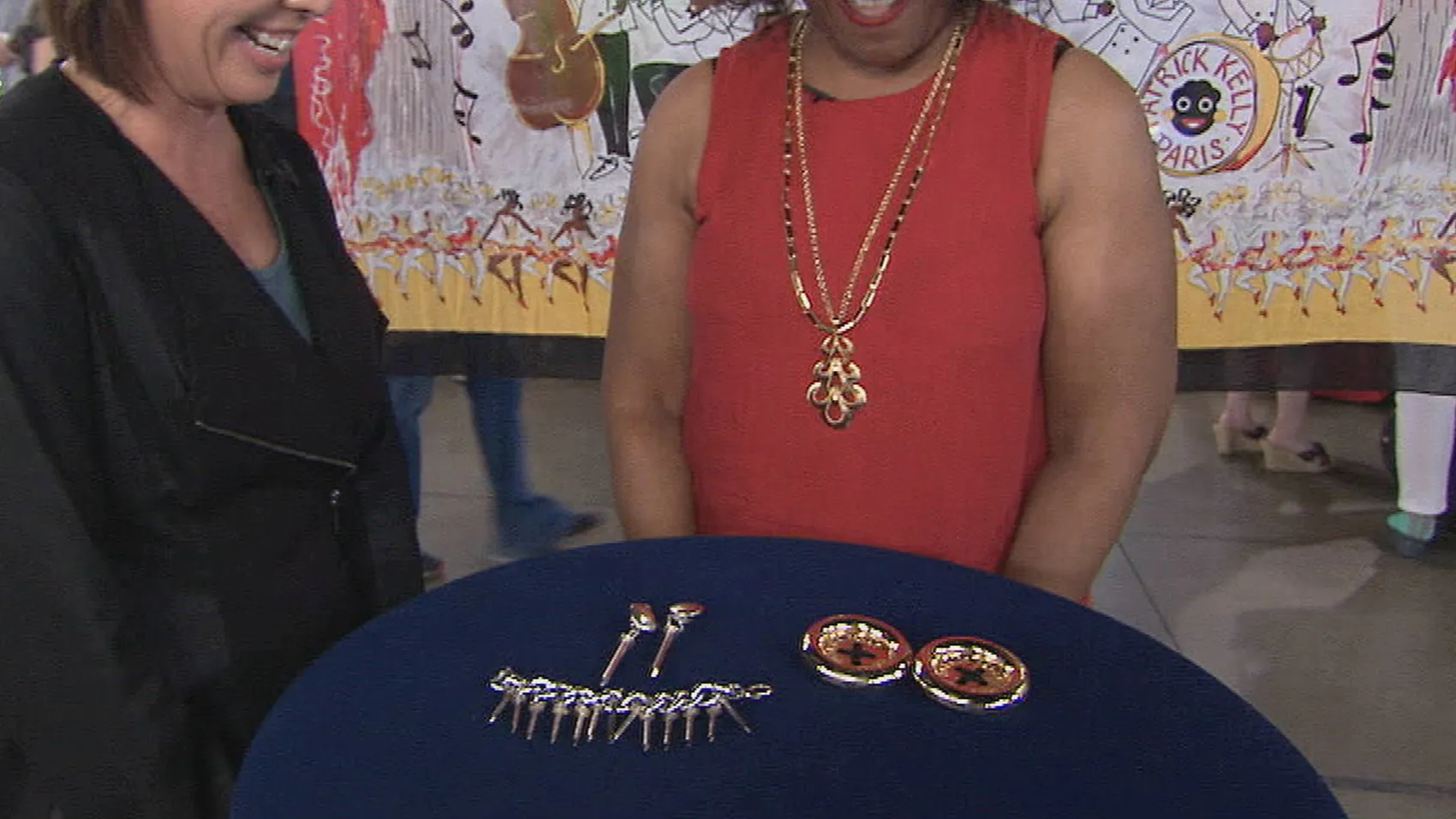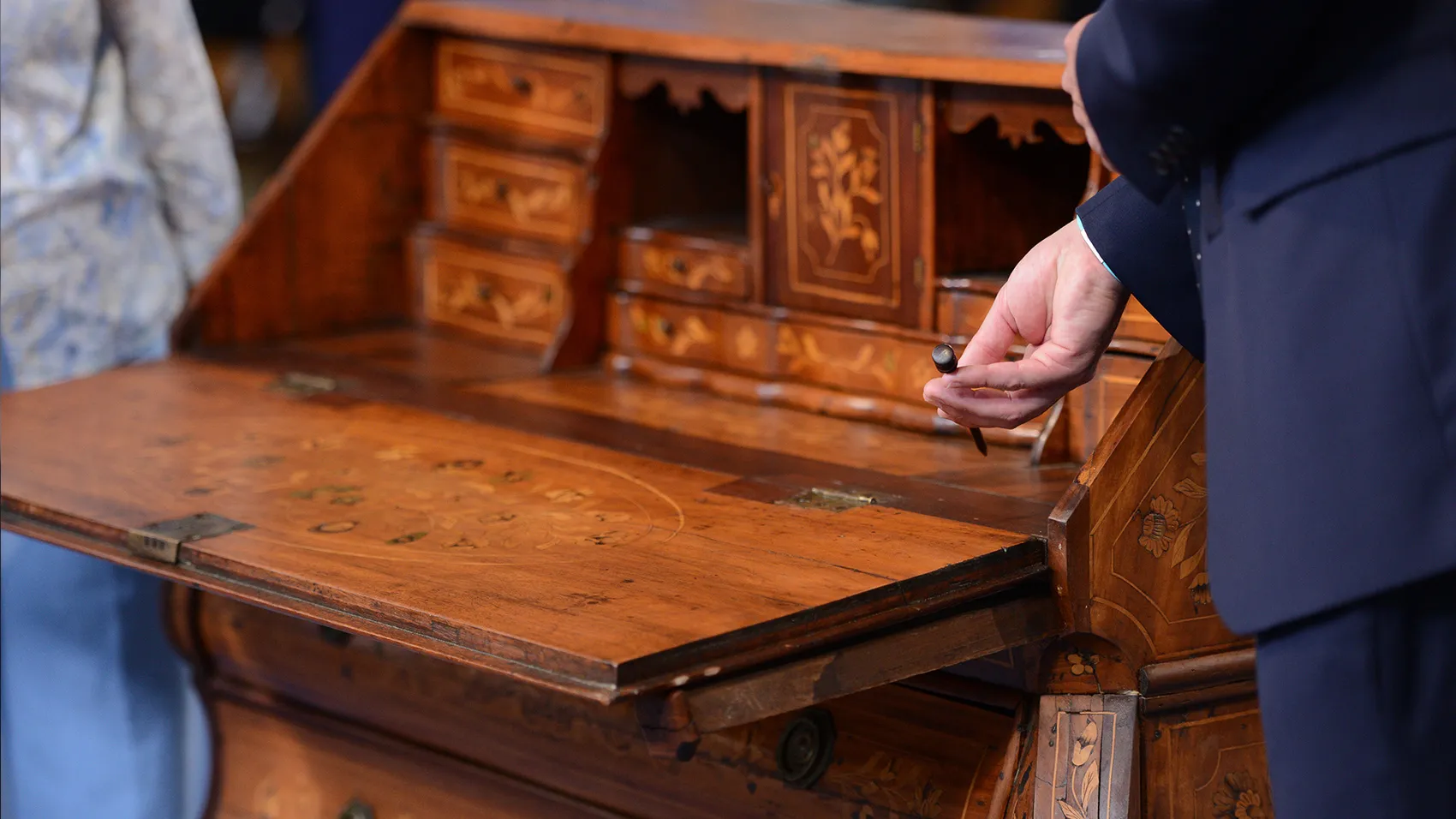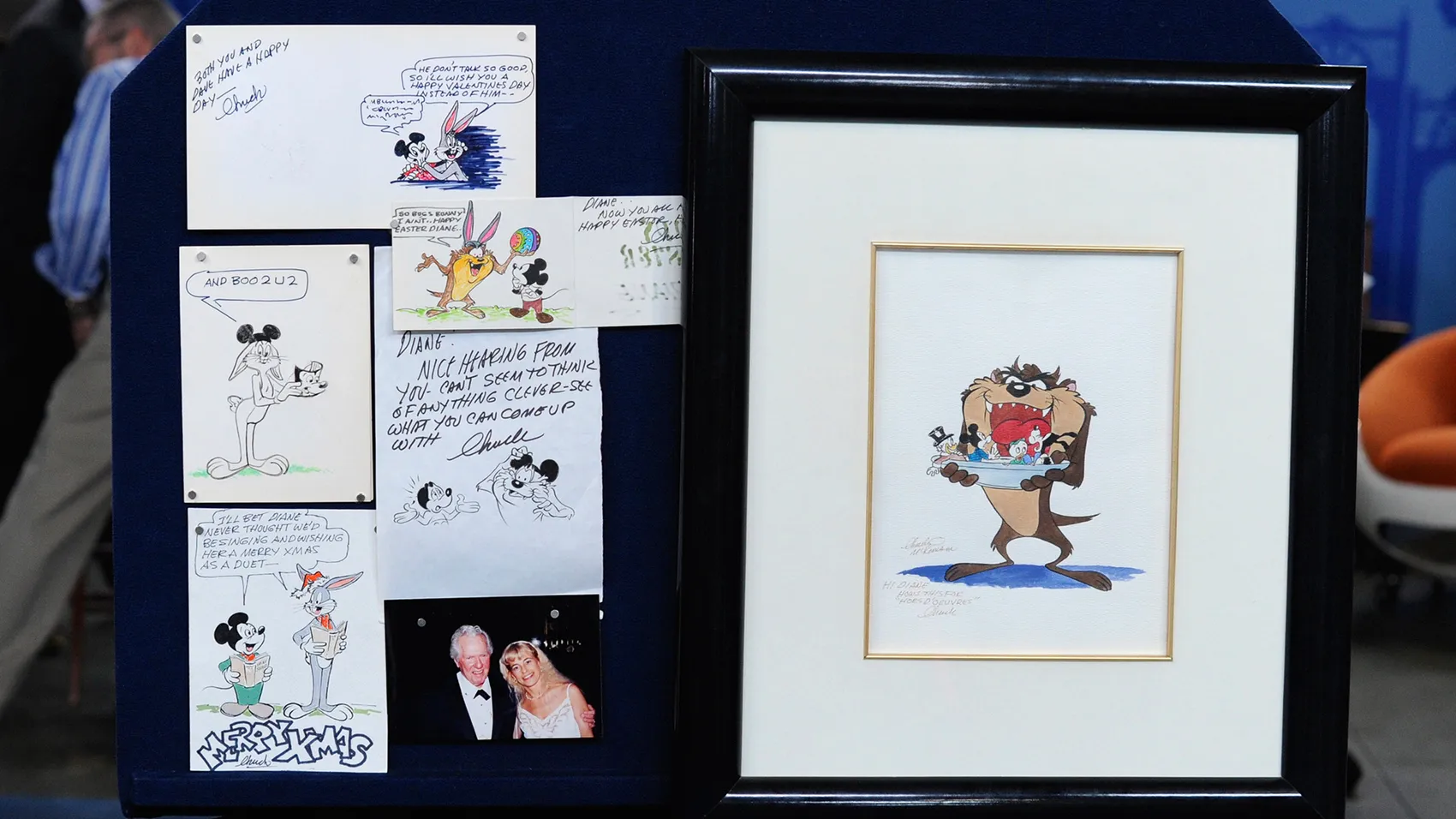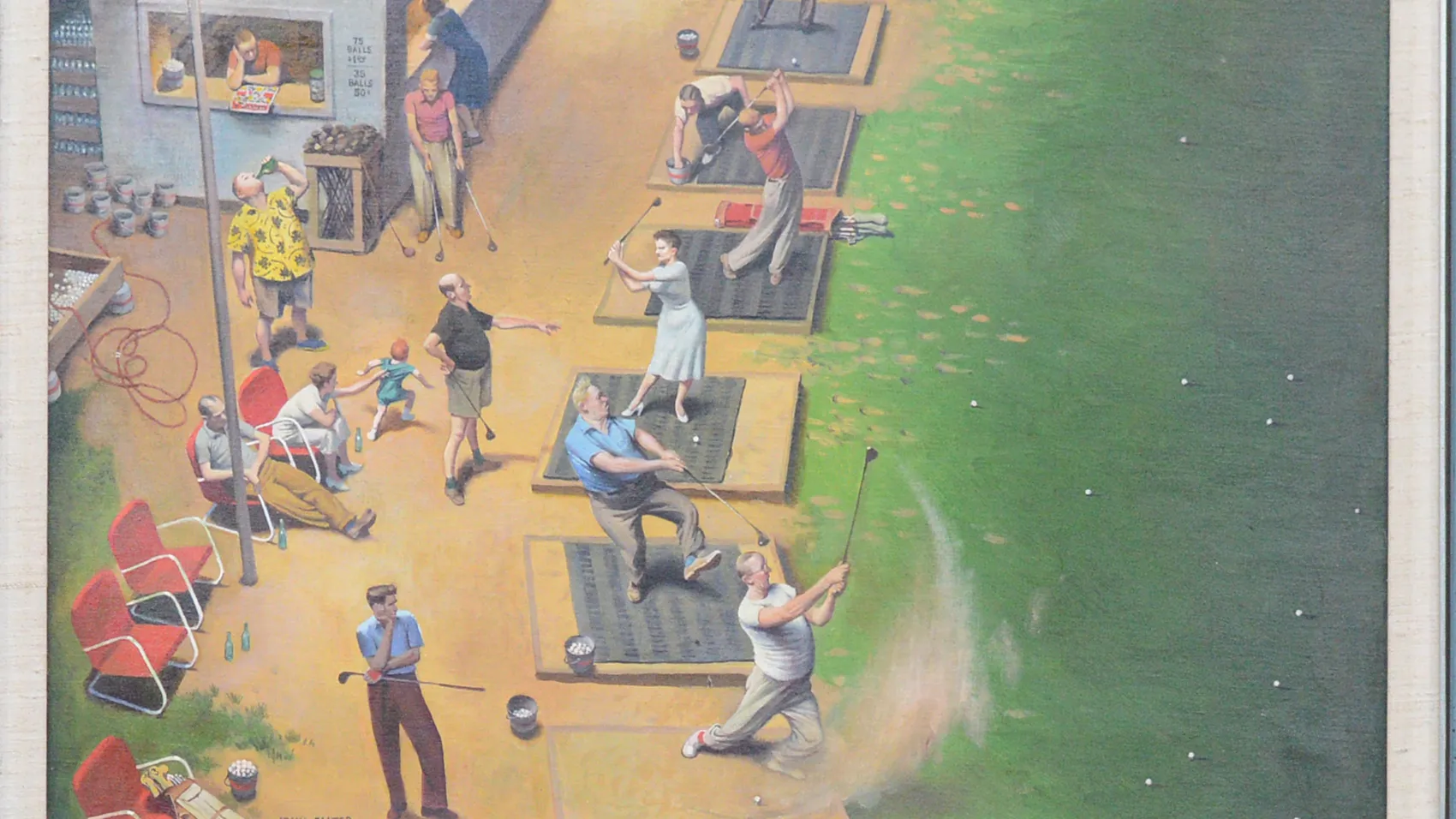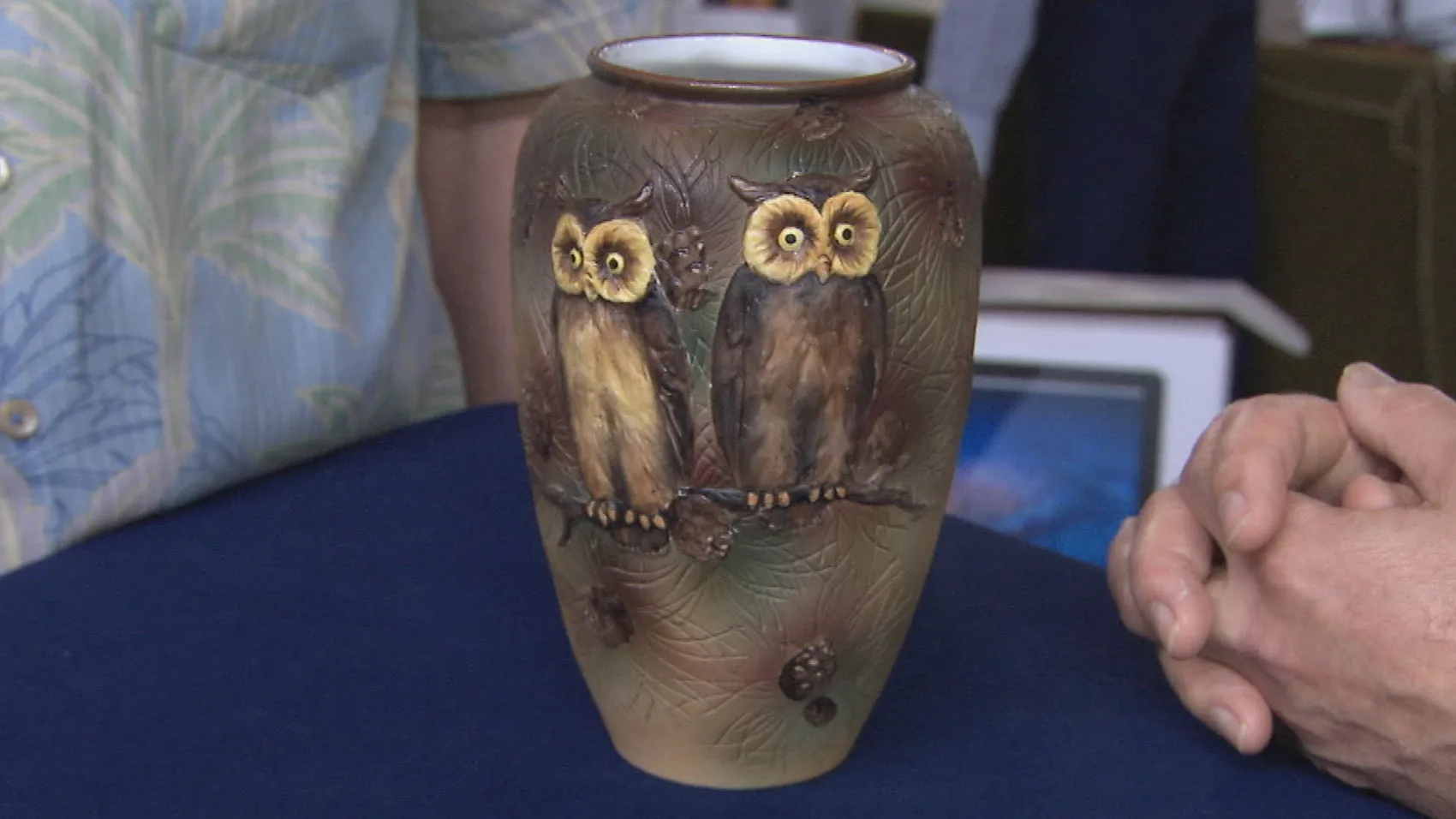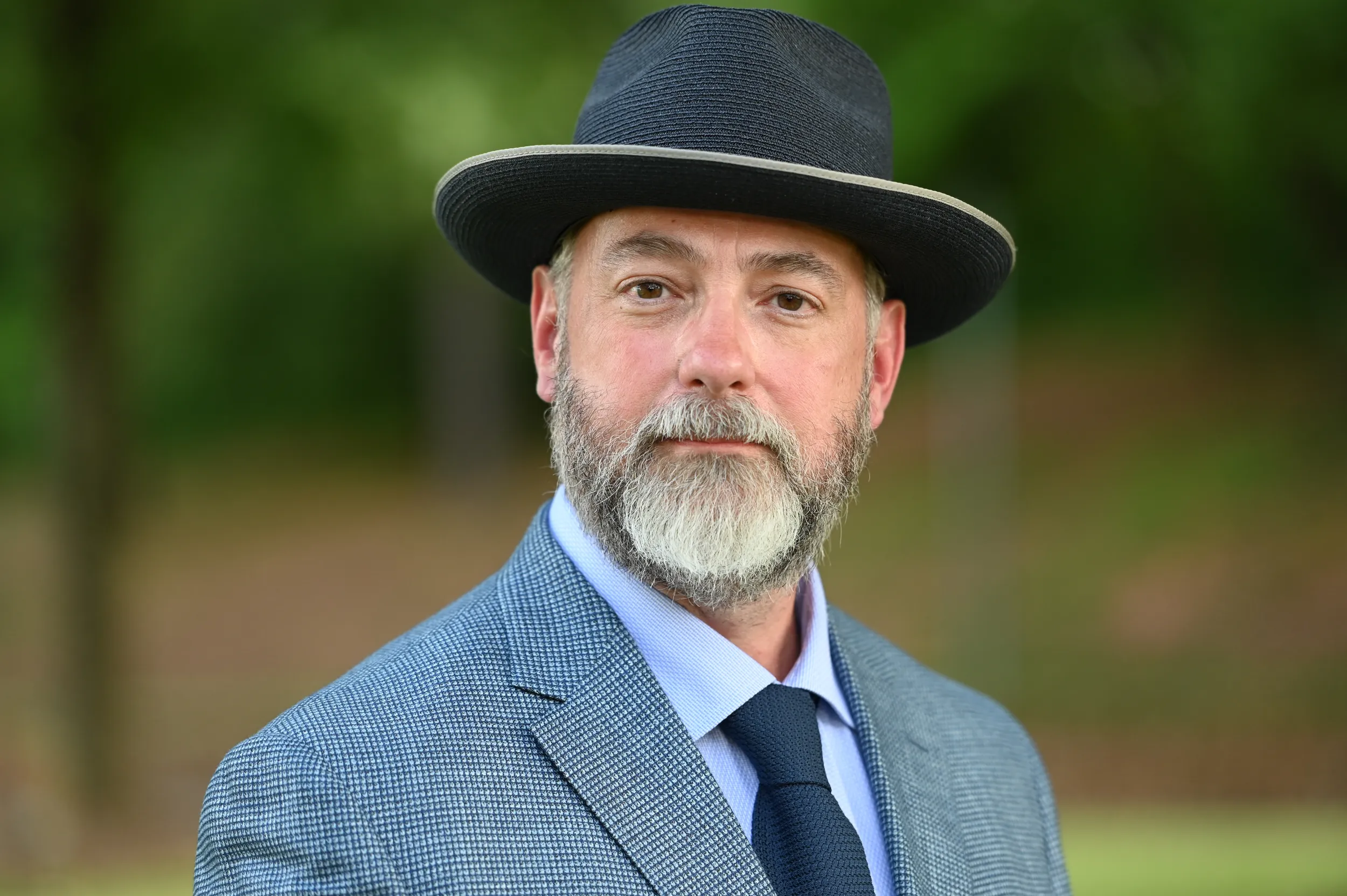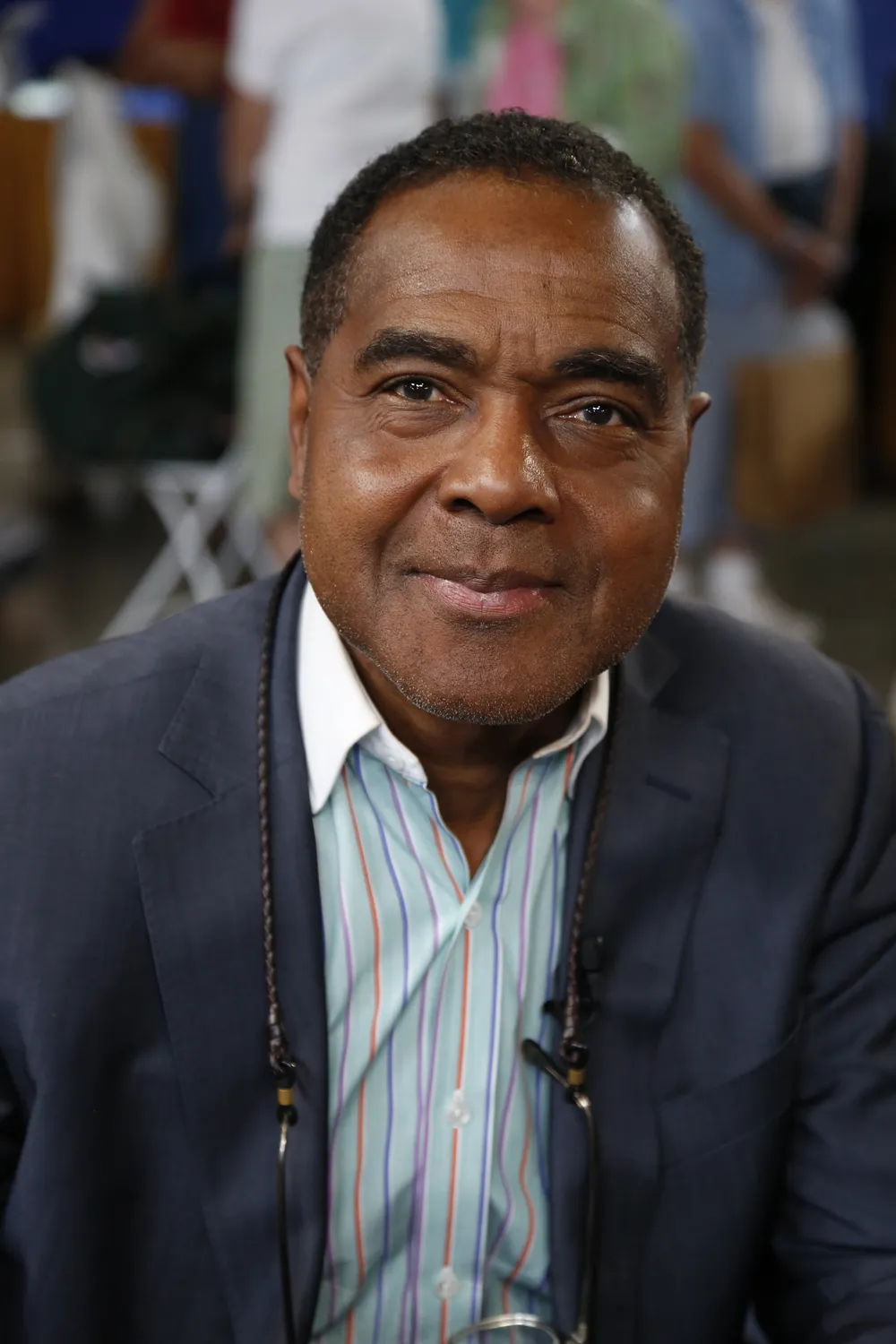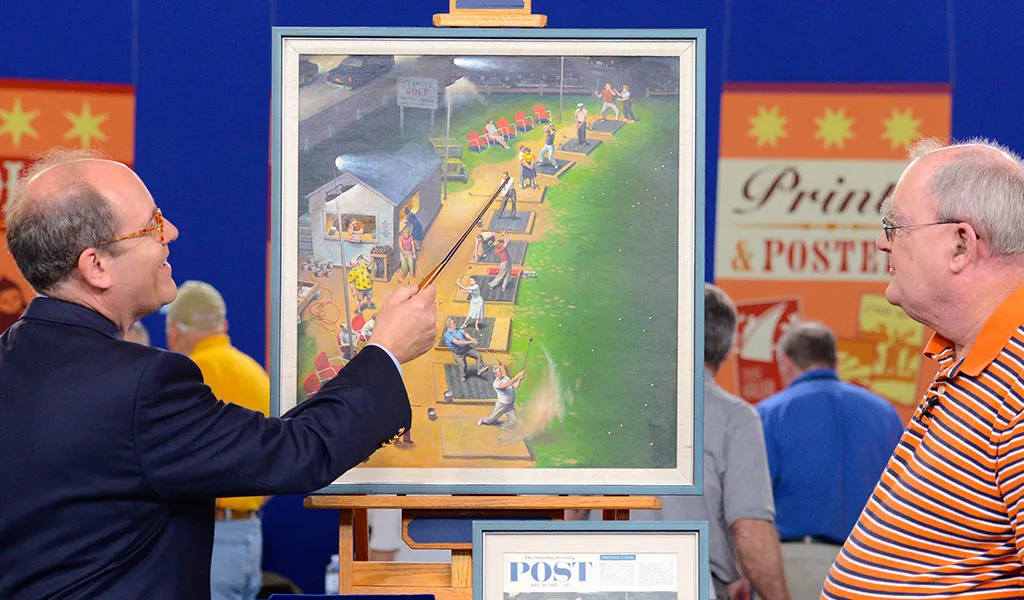HOST: ANTIQUES ROADSHOW is visiting Birmingham, Alabama.
APPRAISER: Can I ask what your boyfriend thought of it when you brought this home?
GUEST: He was kind of skeptical.
GUEST: Holy buckets! And I killed a bug with it once.
GUEST: What? Can you repeat that?
GUEST: Oh my goodness! Good heavenly days!
HOST: Don't miss these and other prized antiques from Birmingham, coming right up.
HOST: Welcome to ANTIQUES ROADSHOW. Hi, I'm Mark Walberg in Birmingham, Alabama, and we've got thousands of people here who brought their items from home all the way to the appraisal table. That's no easy task, and some people got quite creative. So you've got your desk, your dollies, your paintings all together.
GUEST: Everything together.
HOST: And you made it safely?
GUEST: Yeah, I've been running through here with my dress on and everything.
HOST: And you brought a hired hand just in case, huh?
GUEST: Yes, that's my son Chandler.
HOST: Are you having fun, Chandler? Excellent, well, good luck to you.
GUEST: Thank you.
HOST: Thanks for making the trip. What other items made the trip safely to the appraisal table? Well, take a look.
GUEST: In 1968, I was working in a campaign for a candidate for governor of Arkansas, and across the street was the Bill Fulbright campaign, and a young man was working for him, and we became good friends. He had just graduated from Georgetown University, and after the campaign was over that summer, he went off to Oxford to go to school. He was a Rhodes Scholar. And his name happened to be Bill Clinton. We corresponded with each other, and this is a letter that he wrote me in response to a letter I had written him. It was written the Sunday before the election in 1968, and he talks about in the letter that "By the time I get this letter, we'll know who won the campaign." This was sent to me, and also a flyer. He had apparently been to an anti-war rally, and he was wanting to show me what was going on over there.
APPRAISER: Now, you said he criticized you on something?
GUEST: Yes, the first paragraph, he talks about I didn't put enough postage on the letter to him and to include more postage next time I wrote.
APPRAISER: This is sort of a general letter. He's just talking about the elections, the details. But there was one paragraph in this...
GUEST: Yeah, it's towards the end of the letter. He says he's been playing rugby a lot, and "I've got a cut over my eye," and he said, "Maybe it'll be enough to keep me out of the draft," and he says, "Wishful thinking."
APPRAISER: Boy, I imagine that he'd be happy not to have had that letter come out when he was running for president. Did he have other sentiment like that?
GUEST: Yes, he was very much of course opposed to the war, although he's very critical in that flyer of the people who are attacking the war, that they really aren't saying very much that's important.
APPRAISER: So this was a demonstration in London.
GUEST: In London.
APPRAISER: Let me turn this around.
GUEST: He says that there's a lot of the false statements and things that he's seen in an Arkansas political campaign and referencing that to me, because both of us were very interested in politics.
APPRAISER: So he's very much criticizing the speaker here, and saying basically the same bull that's going on there is going on in Arkansas.
GUEST: That's right.
APPRAISER: Again, maybe something that, when he was running for governor, wouldn't have made him as popular.
GUEST: No, not at all.
APPRAISER: So this is a nice, long letter, hand-written, lends insight into his character, his personality. It's signed "Bill" because you were a friend, so he's not going to sign it "William Jefferson Clinton." It's a fabulous letter. Have you ever had these appraised?
GUEST: Never have. I've never shown them to anyone until today.
APPRAISER: Never... oh! Well, let's start first with the demonstration. I would say that that note is probably a minimum retail value of $2,000 to $3,000. And the letter, it's a great letter, and it's hard to compare this because most of the letters that you see are on presidential stationery, which is good, but they don't give young Clinton's attitudes and what he thought. I would say easily retail, this is a $10,000 letter. Easily. So the combined, $12,000 to $13,000 retail on a very conservative basis.
APPRAISER: Do you have a lot of other correspondence from Clinton?
GUEST: No, I just happened to save this. We corresponded about once a month, but I just happened to save this letter, I don't know why. Strangely enough, I really thought someday, this guy might be president of the United States. He was that impressive at that age.
APPRAISER: Why didn't you save all the rest of them?
GUEST: I don't know. I should have, shouldn't I?
GUEST: This is a clock that was my great-grandmother's. She lived in Colombia. She gave it to my grandfather, and when my grandfather died, he gave it to my dad, who brought it here. And I've always loved it, so he gave it to me. We assume that she got it in Colombia, it was from Colombia.
APPRAISER: That's interesting, and when your father brought it back, he not only brought the clock to America, but he also brought you.
GUEST: Yes, not on the same trip, but yes.
APPRAISER: This clock would have been made for the South American market. We know that because it has these calendar rolls, and the month and the day are written in Spanish.
GUEST: Yes.
APPRAISER: This was made by the Ithaca Clock Company in Ithaca, New York. The company first formed about 1865.
GUEST: Okay.
APPRAISER: And this is probably their prettiest shelf model. The case is walnut, and it has these wonderful Victorian accents that are applied in black, and it also has a really interesting dial format where the upper dial is blacked out with silver figures and the bottom dial's glass, and it's painted on reverse.
GUEST: Okay.
APPRAISER: So in the 1860s, '70s, and '80s, America was really responsible for sending inexpensive time all over the world. This clock wouldn't have been an inexpensive clock; this would have been a very expensive clock.
GUEST: Okay.
APPRAISER: And for it to go to a foreign country meant that they had a ready market for expensive clocks like this.
GUEST: Wow.
APPRAISER: And it has a lot of appeal because it's not only a clock that tells time and strikes the hours, but it also has a calendar feature that tells you the month, the day of the week, and the day of the month-- that's what this outer ring is. And all of that is in really wonderful condition. It is missing a calendar hand. And if you look closely on the pendulum bob here, it has the company's trademark engraved in the glass. Now, one of the neat things about this calendar clock is that it's perpetual, and perpetual means that if you keep it wound and it's set up correctly, then it will follow the variations of months automatically-- it'll change. And it'll also follow for leap year. It's kind of the standard complicated clock of its day.
GUEST: Yeah.
APPRAISER: The model number's called the Three-and-a-Half.
GUEST: Okay.
APPRAISER: Do you have any idea what the value of a clock like this is?
GUEST: I don't. I would guess maybe a couple hundred dollars, just because I don't know. I just like the way it looks, so...
APPRAISER: This is a very popular clock, and it's a very desirable model. If it were to sell at a clock auction, it would probably sell for $2,500.
GUEST: Wow! Yeah, I would have never guessed that. I would have never guessed that at all. My dad will be happy.
APPRAISER: If it was five years ago, a clock like this might have sold for another $1,000 more.
GUEST: Okay.
GUEST: My great-grandmother brought it over on a ship from France, late 1800s, early 1900s. Of course, my grandmother had it and then my mother, and it was passed down to me. I know it's got human hair, the pierced ears. I guess it's porcelain-faced, isn't it?
APPRAISER: Yes, it is. Did it have clothes when you got it?
GUEST: It had pantaloons and a slip. And my mother had a new outfit made for it.
APPRAISER: This is a Jumeau doll from Paris. They made dolls from 1842 up until about 1898. These dolls were the best quality French dolls. It has a human hair wig, and also the coloring of the bisque, the contrast between the paleness and the rosiness in the cheeks. And it's a very early model. It has a papier-machÈ body, eight ball joints, which denotes that it's a lot older. It's very desirable because of the blue paperweight eyes.
GUEST: Oh.
APPRAISER: Any doll collector would love this. If you compare dolls to jewelry, you would think that this would be like a piece of Tiffany to a doll collector because it's really a great example. On the back of the head, there's a size number. Size number 11, which denotes it's a 24 inch. Most of the earlier models like this weren't marked on the head. They were either marked on the clothes or on the body. And you can see the Jumeau mark here.
GUEST: Right.
APPRAISER: If you look at the bisque head, also, you'll notice that it has pierced ears. The ears are also applied. They were put on after the doll has been molded. And the earrings look to be original. They're little glass balls. You see some damage around on the body.
GUEST: Right.
APPRAISER: It doesn't hurt the value at all. It's just typical wear and tear.
GUEST: Yeah.
APPRAISER: Today at auction, this doll would bring between $16,000 and $18,000.
GUEST: Wow.
APPRAISER: Yeah. And if you had the original clothes, you could add another 20% to that.
GUEST: Oh, really? Wow.
GUEST: We think it's a ceremonial robe from China. Our cousin was a Navy medic in the Second World War. He acquired it in China when he was there. He married a Chinese lady, a beautiful Chinese lady, and stayed there for about a year or so after the war was over, and he brought it home.
APPRAISER: These robes are not always easy to display. Did the urge to chop it up and frame it ever enter your mind?
GUEST: Never thought about it.
APPRAISER: Well, I'm so glad to hear that, because too often, we see wonderful Chinese robes that have been chopped and mutilated and framed and glazed, so it's a wonderful thing that didn't happen. Chinese robes come in various styles and forms. Some are single-toned. However, this is vibrantly colored. This is a summer robe. It's a very light, breathing gauze fabric, and this would be worn to the exterior of other clothing.
GUEST: Who would have worn it?
APPRAISER: These robes, and the colloquial term is often "dragon robe," were worn in the imperial palace. However, there were a huge volume of servants, officers, court attendants who would be required to wear these, so they're not terribly rare. Now, when we look at a Chinese robe, there are a few identifying features that tell us a story. First is the dragon, gilded dragon in gold thread. In this instance, it represents the mandate that the imperial household has to govern, and good governance to the people. Now, around the dragon are these circular silver spheres. These are often referred to as the flaming pearls of wisdom, and often the dragon is chasing these flaming pearls of wisdom. It was probably manufactured within 1900 to 1911-- late dynastic China. One sold in London, 1990, 1991, for about $550. The market's changed, these are very decorative, and in the Chinese antiques market, you get a lot of decorative arts. So a conservative auction estimate would be $4,000 to $6,000.
GUEST: Nice. I like that.
APPRAISER: For insurance purposes, probably around $8,500 to $10,000.
GUEST: Oh my gosh! That is amazing.
GUEST: One of them came from a garage sale, the one on my left, and this one came from a dealer.
APPRAISER: What'd you have to pay for the big one?
GUEST: I thought I paid too much. I paid $100 at a garage sale. But after I look at it, I really enjoy it quite a bit.
APPRAISER: It's done by an artist named Paul Daschel, who is probably the preeminent Austrian secessionist ceramic maker. Daschel's work is always well-respected by collectors, and this is a very, very fine piece. If we can show the Paul Daschel purple mark, "PD." The other piece is a bit of a mystery. We looked at this, a couple of my colleagues, and neither of us knew the name. It's Robert Hanke, and we can show the mark on that as well. It's also an Austrian piece, and it's an amazing little piece, with the bird and the design on it. Value, any thoughts about value?
GUEST: 100 bucks.
APPRAISER: 100 dollars.
GUEST: Plus, uh, I think I paid not very much, $40 to $50, so I felt like I got a great deal here.
APPRAISER: Well, both of these date from roughly 1905, I would say. The Daschel piece probably at auction, somewhere between $3,000 and $4,000. $100 sounds pretty good right now. The Robert Hanke piece, even though we don't know much about him, this is a piece that should be maybe in the $500 to $750 range, just because of what it is.
GUEST: Thank you!
APPRAISER: You're more than welcome, thank you.
GUEST: I appreciate this, this is great.
GUEST: I brought in a ball and chain, and on there, it says, "San Quentin Death Row, California." I got it at an antiques store in Pigeon Forge, Tennessee. I just saw it and it just really caught my eye. Where can you really find a ball and chain anywhere? I paid $200.
APPRAISER: Can I ask what your boyfriend thought of it when you brought this home?
GUEST: Um, he was... kind of skeptical. He was like, "Is that a ball and chain in the corner of your room?" and I'm like, "Yes," and I explained to him that I've been collecting antiques since I was 16 years old and I've always wanted to find the oddest things that I could find.
APPRAISER: Well, San Quentin is the oldest prison in California, which opened in 1852 and is still in operation today. And it's where the death row is located for men in the state of California. It was made incredibly famous in the 1969 concert "At San Quentin" by Johnny Cash, which was a follow-up to his previous concert performance, "At Folsom Prison." And there's a really wide collecting field for prison memorabilia. There are prison employees that collect these types of things, and then there's a totally separate group of magicians that collect handcuffs, balls and chains, things like that. What we have here today, it says "San Quentin Death Row," and it's been patinated to look old. This is a deliberate fake. It is not antique.
GUEST: Oh, wow!
APPRAISER: It probably was never in San Quentin, I'm sorry to say.
GUEST: Oh, wow.
APPRAISER: And you paid $200 for this?
GUEST: Yes.
APPRAISER: These have sold at auction for around $150 to $300 in the past, so I think you've done okay because you still have an interesting item that's obviously a great conversation piece.
GUEST: Oh, wow. Okay, I'm really glad that I found that out about that. That's really interesting.
APPRAISER: If this was an authentic ball and leg chain from San Quentin, I would expect it would have a value on the retail market of around $1,500.
GUEST: Oh, wow. I mean, it's not that big of a disappointment, it's still something cool to have.
APPRAISER: It's still worth what you paid for it.
GUEST: I would have paid so much more. It would have been probably a good amount.
GUEST: This guitar belonged to my grandfather, and from what I know, he bought it in either 1954 or 1955. He lived in southeast Missouri at the time that he purchased it just a few miles north of Memphis. I think he paid $225 for the guitar maybe and $25 for the case, which in '54 was a lot of money for a man that farmed. It's been a part of my life all my life.
APPRAISER: Being a one-owner guitar, it's dirty, it needs to be cleaned, but it isn't like it's passed around. It was used, he loved it, he put it back in the case. I love that kind of patina on a guitar. It has some issues, but nothing that couldn't be polished up if you need to, but I don't know that I would do that because I'm sure you enjoy looking at it just like it is.
GUEST: I do, it reminds me of him.
APPRAISER: What did he do, what kind of music did he play?
GUEST: He played a lot of gospel music and he played a lot of country music. A little bit of that new rock 'n roll, a little bit every once in a while. When he wasn't working, he would maybe sit out on the porch and pull out the guitar, hook up the amp, and he'd just sit there and play for a long time. And we'd sing together, and that's where my love of singing came from.
APPRAISER: That's what an instrument's supposed to do is bring people together. From best I can tell, it's a 1955 Les Paul Special. They made the Les Paul Special in two configurations. This is a single cutaway. They also made it in a double cutaway. I've always thought that the single cutaway was a more attractive guitar, it's a nicer-looking guitar. This finish is called a TV Yellow, and they made this color specifically to look good on camera, good on TV. Everything on the guitar is original, and like I say, it’s had some wear. The tail piece is original. It's been broken, but it hasn't fallen apart. Pretty common. Some rust and corrosion here and there. The frets are worn, the tuners are original. He bought the deluxe case with it. A lot of times, these came in a soft-shell case. I would value the guitar and case in this market, which is not as strong as it was maybe in 2008, it's still between $10,000 and $12,000 in a retail environment.
GUEST: Wow, I had no idea.
APPRAISER: The case itself adds about $2,000 to $2,500 to the value of the guitar.
GUEST: Wow! So don't separate them, it's very important. Okay, I won't.
GUEST: Andy Warhol was in Birmingham in 1976. He appeared at the Birmingham Museum of Art. The morning before that event, he was selling the book, which was The Philosophy of Andy Warhol. He asked if I would like for him to sign it, and I said sure. He also signed the celebrity register that I had, too. But he drew the tomato soup can, and awhile later, I cut that piece of paper out of the book because after I'd read the book, it was pretty pathetic, but I liked what he did by signing it.
APPRAISER: So you read the book and...
GUEST: And I gave it away.
APPRAISER: You gave it away. You didn't care for it too much.
GUEST: No, I didn't care for it.
APPRAISER: Do you remember what the book was about?
GUEST: His crazy ways of going to shop for groceries and sending people off to do things, you know, for him. It was involving The Factory.
APPRAISER: We do have an inscription to Richard, and then he's titled it "Campbell's Soup." And then we have a signature, "Andy Warhol, Birmingham, '76." And the book came out in 1975. And he did do these book signings regularly, so we do see many copies of either the book with the signature and a drawing or simply just this page, where people have removed it from the book. So Andy Warhol is quite an important artist and really the most important artist of the pop art movement. He is most well known for a few images. Probably one of the most famous would be the Campbell soup can. So you have a couple of great things here. You have a drawing of one of his most important images, you have something that comes from his heart in that he wrote this book and it really meant something to him, and you have a great provenance, which is very important with Warhol. As you've probably heard, there are lots and lots of fake Warhol drawings, prints, everything out there because he's become so valuable. I would estimate this for auction today at $3,000 to $5,000.
GUEST: (laughs) What? Can you repeat that?
APPRAISER: We would place an auction estimate of $3,000 to $5,000.
GUEST: That is totally amazing. Totally amazing. I'm delighted.
APPRAISER: The book itself, I did speak with my colleagues at the books table, and we see copies of it come up for auction. Usually, they sell for a few hundred dollars. Copies have come up with the drawing inside the book, and they bring about what the drawing itself brings, so you didn't really lose much by giving the book away. It's really this drawing on this page that's the value there.
HOST: The Roman god Vulcan created for the 1904 St. Louis World's Fair is a towering reminder of Birmingham's place in the history of American iron and steel production. The giant was made from ore smelted in the nearby Sloss furnaces, an industrial powerhouse that helped give Birmingham the nickname "The Pittsburgh of the South." Now a national landmark, ROADSHOW joins Stuart Whitehurst at the Sloss furnaces to take a look at some desirable iron and antiques.
HOST: Normally, we think of places like this and we immediately think of industrial uses of iron-- railroads, buildings, things like that-- but a lot of great cast iron toys and art and collectibles have come out of places like this, and you've brought a couple to share with us. Tell me about this penguin.
APPRAISER: Well, this penguin is made by the Taylor Cook Company, and it is one of a series of eight animals that were made in the 1930s. If you want a jazzy doorstop, that's a good doorstop to get.
HOST: Back in the 1930s, if I needed to buy a doorstop and I liked this penguin, what would I expect to pay for that?
APPRAISER: It would probably cost you about five dollars at the time. Obviously, a doorstop is going to see slamming doors all the time, and in this paint scheme-- which is the right paint scheme, by the way-- in this condition actually makes it a very desirable doorstop.
HOST: Now, for collectors who have penguins like this in their doors or on their mantles, what's the value today?
APPRAISER: At auction, you would probably expect to pay about $2,000 for that doorstop. If it's a traditional black and white penguin that you would expect to see, that's the wrong paint scheme. Probably worth about a tenth as much as this one.
HOST: I see. Now we have this next piece of cast iron work, and the paint here is amazing given the age. Tell me about this piece.
APPRAISER: This is a Punch and Judy bank made around 1885 in Buffalo, New York, made by the Shepard Company. And what makes this really, really good, you pointed out, is the paint surface. Any mechanical bank is going to see a lot of wear, and the ones that retain their value, do the best, are the ones that have most of their original paint surface.
HOST: Does this still work?
APPRAISER: Yes, it does, yes, it does. And I'm going to put the penny in the pan here, press the lever, and off it goes. Bang, there we go.
HOST: Saving your pennies there. How can we tell if this is an original piece or someone has doctored it up to make it look old but has been repainted?
APPRAISER: That's a really great question. Actually, on the older paints which are applied on cast iron, typically they're oil based, and so they're very thick, so when they chip, they chip with a jagged edge. Modern reproductions often have a sprayed paint, so it's a surface that you can't even gouge away, let alone chip. So when you see those ragged edge chips, you pretty much know that you're looking at an old surface.
HOST: What's the value of a piece like this today?
APPRAISER: Great paint, great bank. At auction, it's probably worth around $4,000.
HOST: Great pieces of cast iron work here, and what a great place to see it, right here in Birmingham. Thanks so much for sharing it with us.
APPRAISER: My pleasure.
GUEST: My husband bought this plate at an estate sale. It's part of a pair. The man having the estate sale said that he and his wife bought it from a Russian countess and it belonged to Alexander III, Tsar Alexander III.
APPRAISER: About how long ago was that, and where?
GUEST: It was about 12 years ago here in Birmingham.
APPRAISER: And what did you say when your husband brought home these plates?
GUEST: "Surely that's not real."
APPRAISER: Really?
GUEST: He paid about $400 per plate.
APPRAISER: $400 a plate and you didn't know for sure if it was real. Does he think they're real?
GUEST: He doesn't know for sure. But either way, he said they look nice in our dining room, so...
APPRAISER: Okay, that's fair.
GUEST: Worst case, they're just pretty accents for the dining room.
APPRAISER: Sure. The first thing we want to do when we hear something like this-- did it belong to a tsar or someone famous like that-- we try to figure out if it's true or not, and I have to be honest with you, I just want to tell you up front, it's absolutely authentic.
GUEST: Wow.
APPRAISER: So it is real. If we look on the front here, we have a monogram of the letter A and a crown, and that's the cipher of the Tsarevich Alexander. And this has been decorated with a blue background and fancy scrollwork. And this is a really elaborate plate, but not over the top. And there's a mark on the back. There's an A with Roman numeral three beneath it, and that's for Tsar Alexander III. And "92," and that's for 1892. So that's when this plate was made.
GUEST: Wow.
APPRAISER: This is from a very specific service that was made for the tsars. This service is known as the Farm Palace Banquet Service. And the tsars had dozens of services of china.
GUEST: Wow.
APPRAISER: Well, when the Russian tsar was overthrown, a lot of things were sold off by the Russian government, and a lot of things were given as gifts over the years, a lot of things were probably borrowed or taken, who knows, by servants or whatever. After the revolution, visitors to Russia could buy things that belonged to the tsars.
GUEST: Wow.
APPRAISER: Now, this particular plate would have a retail value from a specialist dealer of Russian antiques of between $2,500 and $3,000.
GUEST: Wow, per plate?
APPRAISER: Per plate, so you've got two, and you can just double that.
GUEST: Wow. That's great news.
GUEST: I brought this silver service that my grandfather had made for my grandmother in 1920, and all I know is that it was made by a shop in Chicago in 1920, but I don't know anything more about it than that.
APPRAISER: Okay, well, it was made by a shop in Chicago in 1920 called The Kalo Shop. The Kalo Shop is very important in the Arts and Crafts movement, and the Arts and Crafts movement was an early 20th century movement where people were moving away from mechanization and looking back to things that were hand-crafted and completely handmade. What's so unusual about The Kalo Shop was that when it was founded in 1900, it was founded by a group of six women. The woman who headed up the shop was named Clara Barck, and then she married a gentleman named George Welles in 1905. Prior to her marriage, the shop focused primarily on leather goods as well as textiles. The husband was an amateur silversmith, so the shop began to produce a few articles of hammered copper and silver, and by about 1917, they were moving to almost exclusively making items of hand-hammered metal. And it's highly unusual to see a large service like yours, and particularly with these original drawings. And you say you have the family monogram in the drawing as well as on the pieces of silver themselves.
GUEST: Yes.
APPRAISER: When you look at the sketches, there are some slight variations. Clearly they do have the family name on these drawings, so these must have been the working drawings from which they made decisions, and at some point, clearly they made some choices to change the final product from the drawings. The most recent record I can find for a silver service, which is very small, with a round tray and only three pieces, the tray only being 15 inches in diameter, and yours is nearly twice that. And that brought $18,000.
GUEST: Oh.
APPRAISER: So we have to talk about something else. Even ivory accents on pieces of silverware like this are restricted, and that is because the elephant population has been decimated by poachers in recent years and it continues to be a problem, and as long as there's a demand for ivory, poachers will continue to try to supply it.
GUEST: Okay.
APPRAISER: If you removed the ivory and replaced it with something else similar in appearance, at auction, the value would be about $30,000 to $50,000.
GUEST: Oh, wow. Well, of course I would never sell it because it's got my initials on it.
GUEST: I've got a friend who's a dealer in Fredericksburg, Virginia. He called me once and said he had found a silhouette of George Washington and just really kind of piqued my interest, and so he emailed me a photo. I said, "I love it, send it to me." He said, "It's going to need some work," and I said, "That doesn't bother me." There was a card on the back that the lady had put that her father or great-grandfather bought it, you know, and where he had acquired it. There was areas missing on the frame and a lot of the beading was either loose and some segments were off. And they pointed out that it originally would have had some type of mat around it, and so the recommendation was to make that black, oval circle the mat.
APPRAISER: So this part here?
GUEST: Yes.
APPRAISER: So you had this glass made, okay.
GUEST: That glass was made.
APPRAISER: And then the paper part, this was all original, and that's just regular laid paper, which is 18th century paper. So what you have is a really detailed silhouette portrait. And it's amazing, if you think about it, how much you can tell from the profile. You know, you look at that and you know it's George Washington. The lace is wonderfully done, this, all in ink. If you look at the back here, you see this looks like a scratch at first, and this is actually the back of his wig, the long hair coming down, and that's negative space here. These two lines I think are probably scratches. Most importantly, you have here "S. Folwell," for Samuel Folwell, and then the date, 1791. Samuel Folwell was born in 1765 and he died in November of 1813. The great thing here is that I see that when you sent it to the conservatory, they put acid-free paper behind that original paper, which is so smart, and then they attached back this original backboard, which is probably yellow pine. And I can read here, "Likeness of General George Washington taken in 1791 while on a visit to the city of Charleston, South Carolina." George Washington was in Charleston, South Carolina, in May of 1791. So you have here Samuel Folwell, who we know worked in Charleston, and he was there in 1791. He worked in Philadelphia, he worked in New York, but this is one place he worked. So you put those two together, and I really think there's a very good chance that this is actually from life. If this were just one of the later portraits-- another one came up with a 1790s date, but not this early. That brought about $9,500, okay?
GUEST: Gosh. That would be great.
APPRAISER: Now, if it turns out to be from life, I think this has easily the possibility of being worth $15,000 to $18,000.
GUEST: You're kidding, wow.
APPRAISER: At auction.
GUEST: It deserves to be someplace special.
GUEST: This was the hood ornament to my father's car. He had it on every car that he ever owned up until 1970-something, and I was born in 1948, and I'm sure he had it on any vehicle he had before that. It was purchased as a hood ornament, from what I understand. It was not on a vehicle when he bought it. It's obviously quite old. My mother had a hood ornament also, which was a rooster. And I wish I had it to bring also, but my sister's got it. It's just a falcon.
APPRAISER: Okay, well, it's a special falcon. This was actually made by RenÈ Lalique, who was the premier glass maker in France during the Art Deco period. And it was called Faucon-- F-A-U-C-O-N-- which means falcon. The Americans call this a hood ornament. The British call it a car mascot.
GUEST: Okay, yes.
APPRAISER: It was probably made in the late 1920s, and they probably stopped making their car mascots by the mid-1930s. For Lalique, car mascots were a very limited run. When it left the factory, this was clear. It was not this beautiful, rich amethyst color. The reason why it became this beautiful rich, amethyst color is that there's manganese in the glass, and that would react with ultraviolet light, or sunlight.
GUEST: Yes.
APPRAISER: So when you tell me that your father had it on every single car, that just reaffirms how it got its color, because this saw a lot of sunlight. Usually when these clear mascots turn amethyst like this, they are not as rich and dark like this. This is very, very special. Now, this is signed. It's signed "R. Lalique." It does have one problem: the tail has a chip on it.
GUEST: Right.
APPRAISER: Now, what's interesting is it's an unusual damage because ordinarily, these fall over and the beaks get chipped, so it's unusual to actually find a chip on the back.
GUEST: Yes.
APPRAISER: Stranger things can happen. Now obviously, when something has damage on it, it does affect its value.
GUEST: Right.
APPRAISER: However, because the color is so deep and rich, that outweighs the damage. And something like this in a retail shop could sell between $5,000 and $6,000.
GUEST: That's outstanding.
APPRAISER: If it had not been outside and it had been a clear piece of glass, it would have been worth maybe $1,500 to $2,000 at best.
GUEST: Even at that, though, that would knock my socks off.
GUEST: I have a couple of pieces from Patrick Kelly, who was an African- American artist who in the late '80s worked in Paris. And I have the earrings and a bracelet and a couple of his pins that he was known for, as well as his scarf.
APPRAISER: He was from Mississippi and he was very much a self-made man. I think it's an absolute shame that he died as young as he did. Unfortunately, his heyday was about a ten-year span during the 1980s.
GUEST: Yeah, he was, like, 30 years old.
APPRAISER: It was really quite a shame, but he's left a treasure trove of designs. We have some of them with us today, with the nail bracelet and the matching earrings as well as the button brooches. With regard to the buttons, those are one of his trademark images. These are fantastic. He had such a fondness for his Southern roots, his heritage, and a joy for life. Would you have any idea as to the current value?
GUEST: I really have no idea.
APPRAISER: The button brooches in today's current market would retail for approximately $200.
GUEST: Each?
APPRAISER: Yes.
GUEST: (laughing) Okay.
APPRAISER: We have the bracelet and the earrings, which are very exciting. The value on these would be $500.
GUEST: Oh! Okay, very good.
APPRAISER: The current retail value on the scarf would be roughly $300 to $400.
GUEST: Okay. I'm happy. I know I didn't even pay probably $50 for the whole lot.
APPRAISER: That's exciting.
GUEST: Right?
APPRAISER: I think you bought it very, very well.
GUEST: It was my aunt's, and she offered it to me. She was an antique collector all of her life. She never told anybody her age. Doesn't even have it on her gravestone, she just has the dates that she died.
APPRAISER: Oh, my gosh. (laughing)
GUEST: But anyway, I thought it was beautiful and so I decided to get it from her, and I think I paid her about $300 or $400.
APPRAISER: And when was this?
GUEST: I think it was in the early '70s.
APPRAISER: So it is in the Dutch rococo style. And this desk was made around about 1890, but it was made in the style of a piece of furniture which would have been made around about 1720 or 1730.
GUEST: Uh-huh.
APPRAISER: And in the beginning of the 18th century in northern Europe, especially surrounding Holland, people became fascinated with marquetry inlay, and this piece has some wonderful marquetry inlay here on the slant front: this wonderful bird within the flower arrangements. And this was at the beginning of the 18th century, and then towards the end of the 19th century, there was a big revival of it and people really couldn't get their hands on enough of it. And so they started producing more pieces. They took old, slightly more boring-looking pieces of furniture and added inlay to them to make them a little fancier, and then they made pieces as well. I wanted to show the inside of the piece. It has this really pretty interior with the marquetry here, also on the door, and then all of the drawers surrounding. It's been exposed to the elements, to the sun a fair amount, and so it's a little sun faded.
GUEST: Did you find the secret drawer in here?
APPRAISER: Where did you find the secret drawer?
GUEST: The secret drawer... ...is right under here.
BOTH: This comes out.
GUEST: And then this comes out.
APPRAISER: Well, they certainly don't make it easy to find the secret drawer, that's for sure.
GUEST: And there's the secret drawer.
APPRAISER: And this whole compartment down here, yes.
GUEST: The whole compartment all the way across.
APPRAISER: So it has a couple of things playing against it. The condition isn't ideal.
GUEST: No.
APPRAISER: And I pointed out some of the issues. And then, interestingly enough, across the board, slant front desks in general have just fallen out of favor. That being said, if I were to see this in a well-publicized auction, I would expect it to bring between $1,000 and $1,500.
GUEST: Oh, my goodness. Good heavenly days!
GUEST: I brought the picture that Chuck McKimson drew for me as a joke back in the '90s-- I was working at an animation art studio as their bookkeeper-- because I'm a Disney collector. I met Mr. McKimson, and my bosses then made a joke about... because I was wearing Mickey Mouse and he's a Warner Brothers guy. So we started a friendship and he drew me this picture making fun of... the Taz eating Mickey Mouse.
APPRAISER: Now, how many years did you correspond with him for?
GUEST: About four, five years. From 1992. That's when I met him. He and I wrote back and forth for a long time. When he traveled around the country and around the world with his animation art, he would write from different places and do a little cartoon on the bottom of the letter.
APPRAISER: You had so many amazing letters, and we could only choose just very, very few of them. Every letter has a handwritten dedication to you, has great little drawings of famous Warner Brothers and Disney characters, you being a Disney fan.
GUEST: Yeah.
APPRAISER: It's kind of interesting that a Mickey Mouse fanatic would make friends with a Warner Brothers artist.
GUEST: I know. That was the joke in everybody, and that's the joke between him and I, also. He was really a nice, wonderful man. We really had a good friendship for being bicoastal friends.
APPRAISER: And animation enemies.
GUEST: Yeah, exactly. He and his brothers are the ones that came up with the Tasmanian Devil, so that's why he did that.
APPRAISER: Well, Charles McKimson, also known as Chuck McKimson, was the youngest of three brothers. He has a brother Robert and a brother Thomas. Chuck himself worked for Tex Avery before he left for the Army during World War II, but they've all worked mostly for Warner Brothers. After World War II, Rob McKimson was doing lots of great shorts for Warner Brother Studios, and his youngest brother Chuck came to work for him as lead animator. And Robert was famous for developing the Tasmanian Devil character, Foghorn Leghorn, Speedy Gonzales, and Charles worked on all of those short films with them. And this is much, much later in life. Most of these date from the early '90s. Right here, you can see a picture of you with Chuck McKimson. Now, when was this taken?
GUEST: In, like, '93 or '94, there was... we called it the animation ball, and it was in Atlanta, Georgia. All the proceeds went to SIDS. Tom McKimson and Chuck McKimson were there.
APPRAISER: Well, what I enjoyed the most about these is him basically having a little bit of fun with you. In each one of these, you've got Bugs, another great Warner Brothers character, basically messing with Mickey. (laughing) Have you ever had these looked at or evaluated?
GUEST: No, I never have mainly because I didn't figure there was any value because it has Mickey and the Warner Brothers together, which is not kosher.
APPRAISER: Well, that's actually what me and my colleagues found the most charming about it. We would estimate, at auction, each of these small Christmas and Easter cards would go for between $300 and $500 at auction.
GUEST: Are you serious?
APPRAISER: And the larger watercolor, at auction we estimate between $1,500 and $2,000.
GUEST: Wow, wow. Well, I would never sell them because, you know, they're very dear to me, but thank you. I'm excited.
GUEST: This is the hunting-fighting knife that my dad, who was a World War II night fighter ace, bought in Florida when he went from California, where he was bomber training, to night fighter training in Florida.
APPRAISER: If he was a night fighter guy, he flew P-61 Black Widows, right?
GUEST: He flew a Black Widow, and his plane was called Borrowed Time. And this was a knife that he picked up on his way. He bought it in Florida because what represented their squadron was a bat, because they were night fighters. And the bat held a dagger in one foot and a service revolver in the other. And he turned his service revolver in after the war, but he kept the knife that he carried.
APPRAISER: Did he tell you what he paid for it?
GUEST: No, I never talked to him about it. I noticed that in the book that you have that comes with the knife, that they were selling these at the time for $15.
GUEST: My goodness, yes.
APPRAISER: Which is kind of a healthy chunk of change.
GUEST: For him at that time. He was very young.
APPRAISER: The fighting knife craze really got kicked off in World War II. Of course, we had trench knives in the First World War, and in the Civil War the guys had bowie knives, but the demand for fighting knives among the Allied service men was very intense during World War II. A number of companies kind of sprang into business to satisfy that demand. A lot of civilian knives were carried. In fact, there was a program where you could turn in your civilian hunting knife and it would be turned over to a marine or a sailor or somebody like that to use. This is not one of those knives. This is one made by a company called Randall. Randall started in 1938 to make hunting knives. That was their business. And then their business really exploded during World War II because of the demand for knives. They were originally made in Orlando, Florida, and if we look at this one, it has the trademark on it and it has the Orlando, Florida, location. They also made them in Springfield, Massachusetts. This is a Randall number 1 fighting knife. The handle is made out of what's called a stacked leather washer grip.
GUEST: I wondered why it was rough.
APPRAISER: Mm-hmm, that's so that you can have a good grip on it. There are several pieces of colored plastic in here, which are simply embellishments that make it look nice, and then it's made out of one piece after another of leather that's stacked up there around the tang. It is one of the fighting knives that is most highly sought after by World War II collects today. They're extremely collectible. The production runs, I wasn't able to find the exact figures, but it's looking like between the two facilities, one made approximately 1,100 and the other made approximately 1,400 of them. So there really weren't that many of them made.
GUEST: Oh, my.
APPRAISER: The nice thing that you have is you have not only the knife, but you have the Randall catalogue and the little Cliff's Notes on how to kill a guy with a fighting knife.
GUEST: Yeah, that's pretty morbid. He kept everything.
APPRAISER: Well, if you're going to carry something, you have to know how to use it. And you never know, if you're a pilot, you're shot down behind enemy lines, you might be in a position where a knife like this could save your life. So have you ever had this appraised or given any idea of...
GUEST: I have not. It's been in a box with his things since he passed on.
APPRAISER: Most of your World War II fighting knives are going to be in the $150 to $200 range. The Randall number 1 with the original sheath, with the catalogue, and with the how-to-kill-a-guy notes-- we also have to factor in the fact that your dad was an ace. Yes. And that's going to add to it as well.
GUEST: Oh!
APPRAISER: On a retail market, I would expect to see this anywhere between $3,500 and $4,000.
GUEST: Holy buckets! And I killed a bug with it once! (laughing) Oh, my goodness. Who would have thought? He would be flabbergasted.
GUEST: I got it through my father. It was something that he had in his home for many years, and when he passed on, it was willed to me, and we've had it hanging in our living room ever since.
APPRAISER: And do you know who the artist is on this?
GUEST: It's John Falter. He's an illustrator, done a number of things for The Saturday Evening Post.
APPRAISER: What was this referred to as?
GUEST: It's called "The Driving Range," and it's a number of different poses of people in various stages of good or bad golf.
APPRAISER: Are you a golfer yourself?
GUEST: I am, yes, so it kind of has some special meaning.
APPRAISER: Yeah, do you identify with any of these characters?
GUEST: With a number of them over time.
APPRAISER: Yeah, your swing changes.
GUEST: Your swing changes, exactly right.
APPRAISER: Well, it's interesting. John Falter did a lot of work for The Saturday Evening Post. He did about 185 covers for them. He was born in 1910 and lived to about 1982. When did your dad get it?
GUEST: He got it back in the '70s, I believe. It was hanging up in the offices where he worked as kind of a rotating exhibit, and when it was time to move out, he contacted the artist to see if he could purchase it. They went back and forth and settled on a price, and that's how he ended up with it.
APPRAISER: How much did he pay for it?
GUEST: He paid $2,500.
APPRAISER: An interesting cover. You know, what's nice about it, it has a lot of appeal to it. Not only is there a lot of interest in illustration art these days, but also, this has appeal to golfers, as well. And going through, it's just really fascinating, all the anecdotes and little stories in here. And he writes in a letter here, he explains all of them. Some of these things, he has which types of swings he's trying to show here, like the low energy shot, over-extended backswing. And we can go up here and look at them and you can sort of go through these. Here's the Fall Forward. And then the Fall Back. And then the Lesson. Here's a man giving his wife a lesson. She doesn't look too pleased with him at that point. The guy here that says he looks really good, but doesn't hit very well. And one of my favorites up here is the Embraceable Youth, the golf lesson there in close quarters. But what's the centerpiece, I think, is this fellow here. You knew in the day, the most famous golfer in the day was Bobby Jones. And he refers to that as Bobby Jones. It also shows an interest in night things. One of Falter's most famous covers is a night game at Yankee Stadium. And also, in post-war, a lot of night sports. And this is what's going on. This is all under the lights here. We have these lights at night at the driving range. Also, you see it's expensive back then. Even 75 balls then is a dollar. That was a lot...
GUEST: A lot of money, yeah.
APPRAISER: For 1952, if you go to the driving range a lot. It's a really good example, and illustration art is one of the hottest things in American art market today. We think of Norman Rockwell and James Montgomery Flagg, but Falter's also one of those artists in the illustration pantheon. He's lesser liked than those, but still fairly valuable. Have you had it appraised, or...?
GUEST: About five or six years ago, we had it appraised for about $80,000.
APPRAISER: For insurance?
GUEST: For insurance purposes.
APPRAISER: That's interesting because in that time, in the last five or six years, the market has really gone up for illustration art. And in fact, he's recently spiked some prices at auction well into six figures.
GUEST: Oh.
APPRAISER: And one of the nice things about this painting is the fact that you have the letter here as well. That adds a certain amount of value to it because it's not just the painting, but you have the explanation, and that enhances the cachet of the piece. Right now, in 2014, it is really sort of at... not quite the peak, but it's really a high time for illustration art. If I were to insure it today, I would probably insure it for over twice that. I would put an insurance value of about $200,000 to $250,000 on it.
GUEST: Really? Wow. I need to make a phone call.
HOST: You're watching ANTIQUES ROADSHOW from Birmingham, Alabama. What's your take on something you just saw on the show? Find us on social media and join the conversation. Coming up, folks recap their Roadshow experience in the Feedback Booth right after this.
HOST: And now, it's time for the Roadshow Feedback Booth.
GUEST: And I'm sorry, Mom, she's pretty but she's not worth a thing. I'll give her back.
GUEST: We came with I Dream of Jeannie dreams. Turns out...
BOTH: We've just got to keep on dreaming. Thanks, ANTIQUES ROADSHOW, we had a ball.
GUEST: I brought these earrings to the ANTIQUES ROADSHOW. Good news, the diamonds are real, just not real valuable, so I'll be back to work on Monday, everybody. Also, I hugged Mark Walberg, and he offered me a co-host position, so good news all around! Bye!
GUEST: We're cousins, so we share jeans.
GUEST: I found out my bull horns were worth $1,000.
GUEST: And that my radio was worth a bunch of bull. (both laughing)
GUEST: I learned that I have a reproduction on my coin bank.
GUEST: I learned I have a real McCoy cookie jar.
GUEST: And I took a selfie with Mark!
GUEST: All right, we're Santa and Mrs. Claus, all the way from the North Pole. We brought my great- grandmother's dough bowl today. I found out it was made out of poplar. It's worth about $250. The rolling pin is not worth anything, but it looks good with it. I had fun! Thanks, bye.
HOST: I'm Mark Walberg. Thanks for watching. See you next time on ANTIQUES ROADSHOW. Look at all this great stuff here. Oh, I love this.
Captioned by Media Access Group at WGBH access.wgbh.org
GUEST: Well, it was given to me as a wedding present back in the early 1970s.
APPRAISER: Okay.
GUEST: And I used it as a wine chalice during the wedding reception. And my daughter, when she married, also used it. And a family friend gave it to us.
APPRAISER: Oh, wonderful. Well, that really matches what its purpose is. We call this a loving cup, and the two handles are symbolic of the gesture that you'd make by sharing the wine. So a bit for you and a bit for me. I won't do it right now, but that's how it worked. It's English. It's got some good age to it. It's probably made around 1740, 1750. A lot of the time with these 18th century loving cups, they're redecorated in the 19th century. The decoration on this particular piece I believe is original to the time of its creation. If this was to come up for auction, I would estimate it to sell for somewhere between $4,000 and $6,000.
GUEST: Oh, what a treat. Thank you so much, that's great.
GUEST: I purchased it at a flea market that I go to. I paid $30 for it.
APPRAISER: $30 is kind of high at some flea markets.
GUEST: Exactly.
APPRAISER: It's a porcelain vase, beautifully made. If we turn it over, we can see the mark. "Nippon" tells us it's Japanese, and this is a mark we find about 100 years ago. This was probably made about 1905, 1910. In an antique shop today, it would be perhaps $1,500.
GUEST: Wow.
GUEST: I brought my 110-year-old trumpet thinking it was going to be worth a lot. It's worth about $400. I brought a Star Wars poster. I didn't think it was going to be worth much at all. It's worth about $1,000.
GUEST: We came in today and I brought my medical bag from Tennessee Coal and Iron Company. This is my fourth trip here to the Roadshow, so I was thinking that maybe this wasn't going to be worth anything, either. Found out it was worth between $750 to $1,000. Yay, local stuff! All right, thank you, guys, have fun.
GUEST: See you later.
